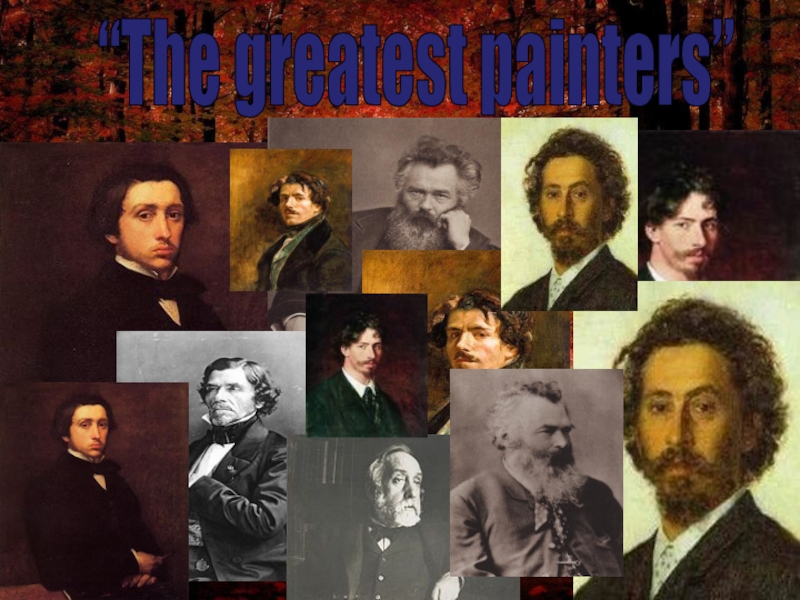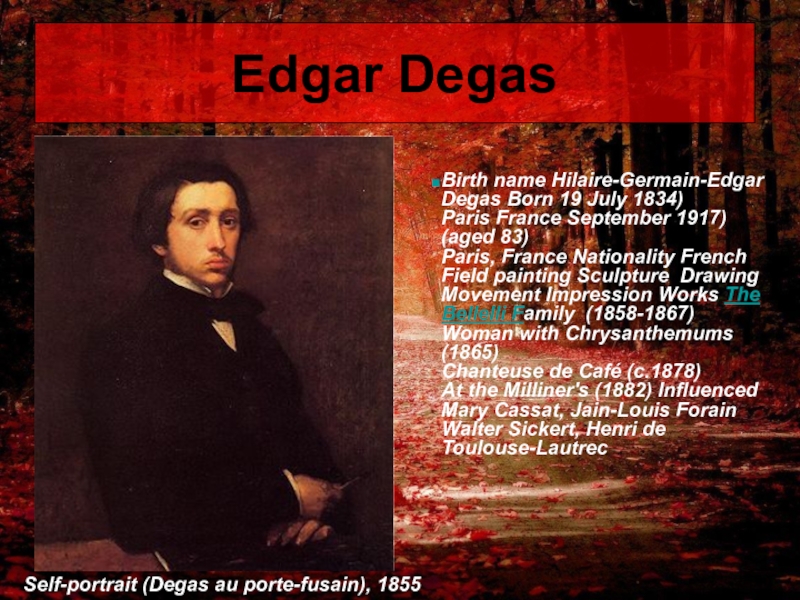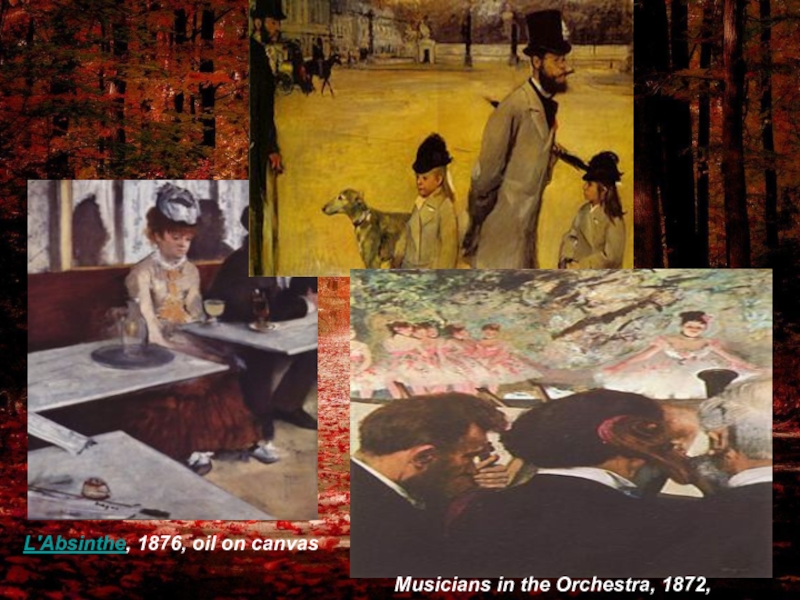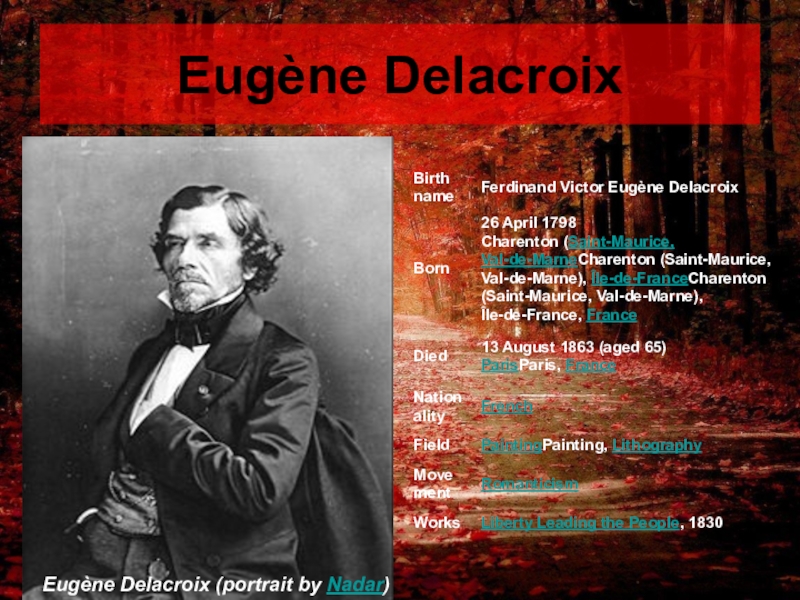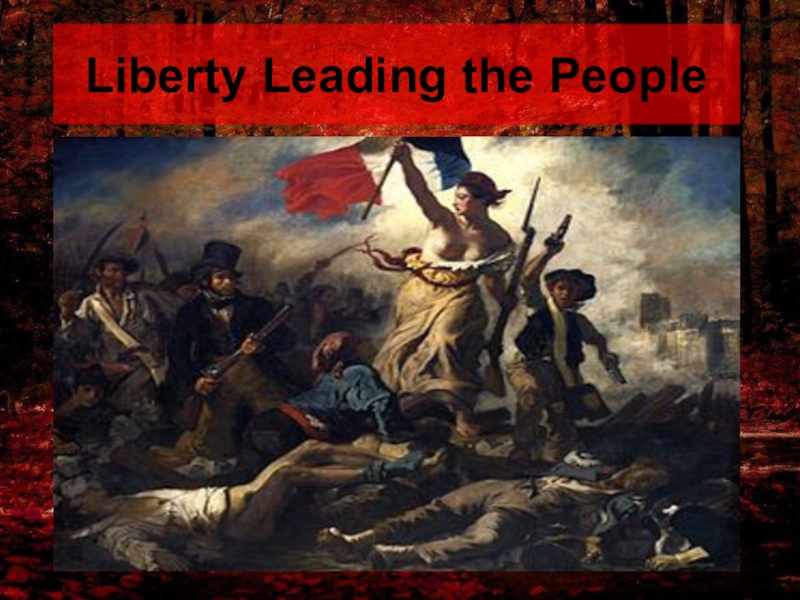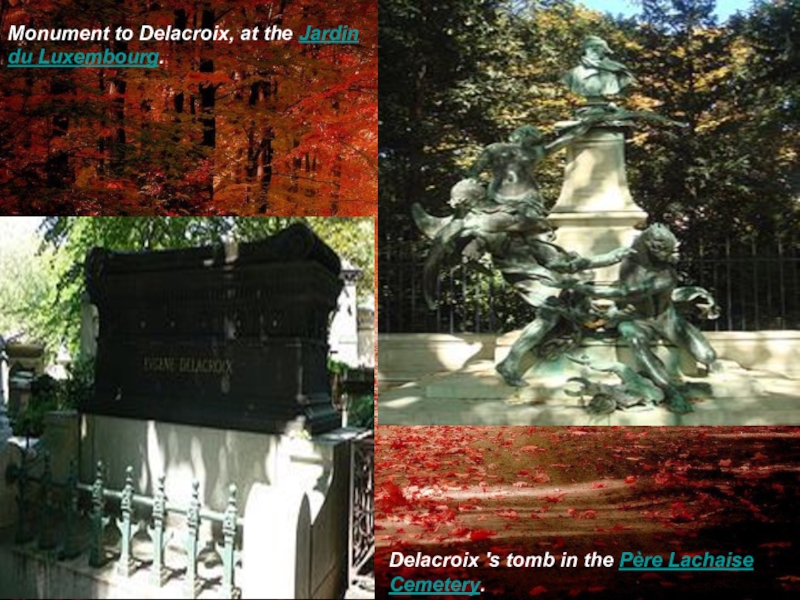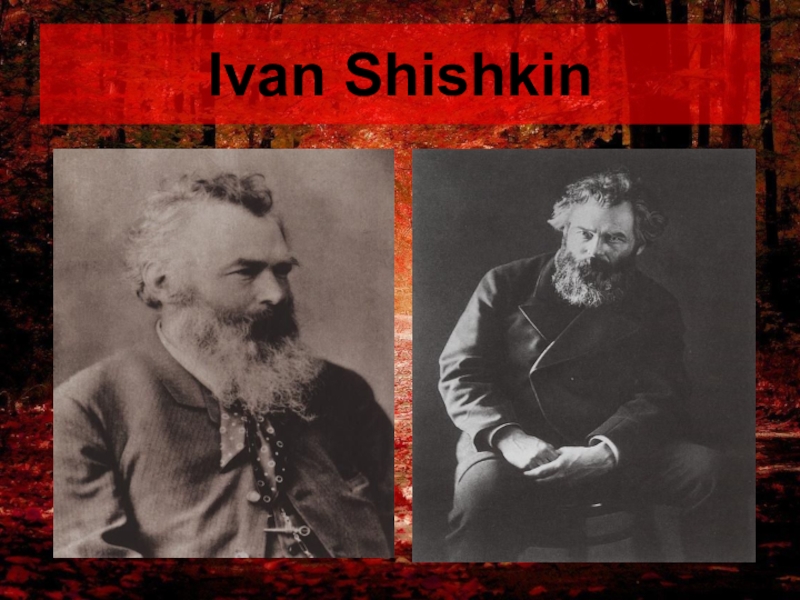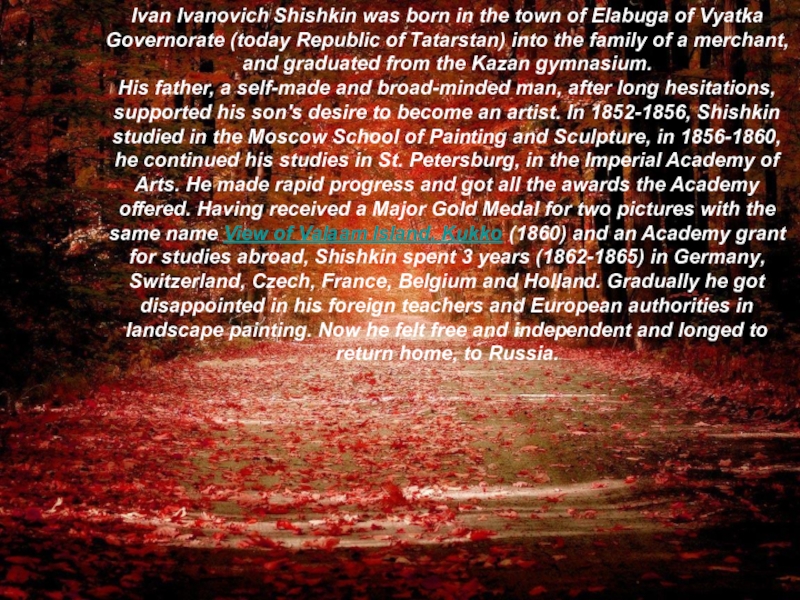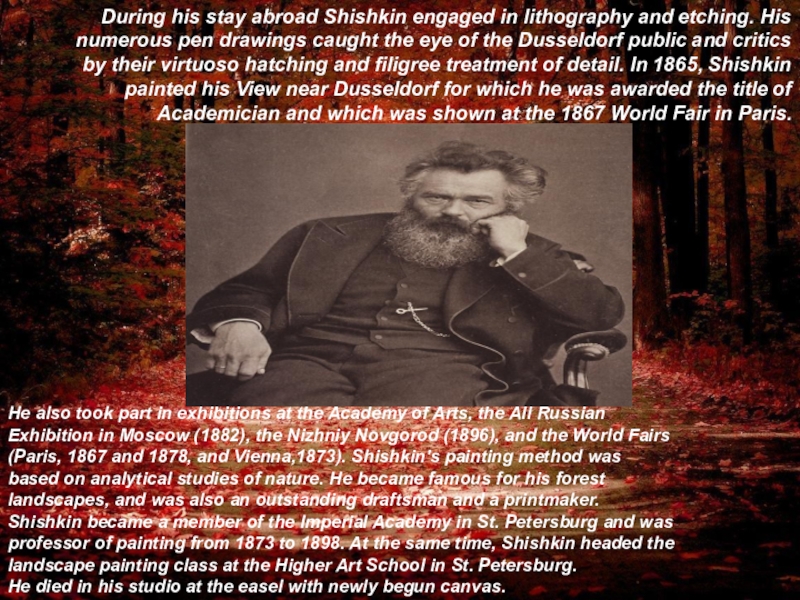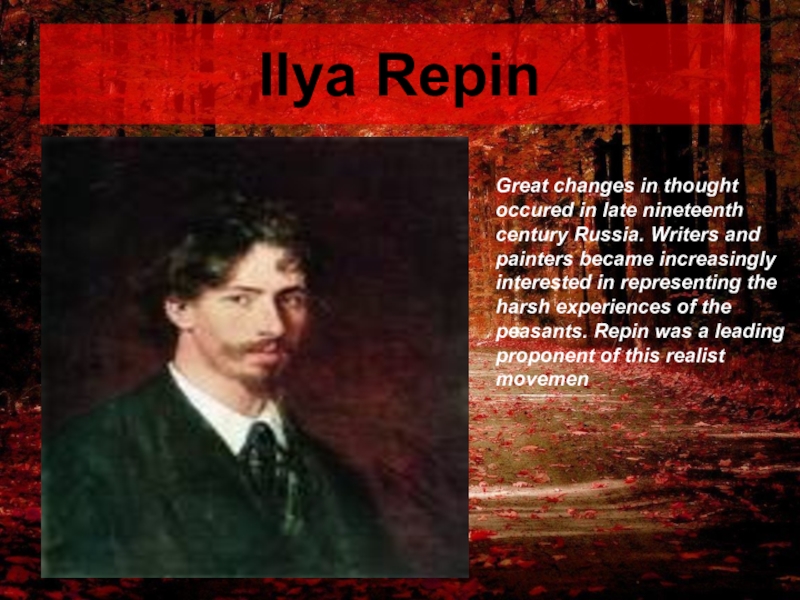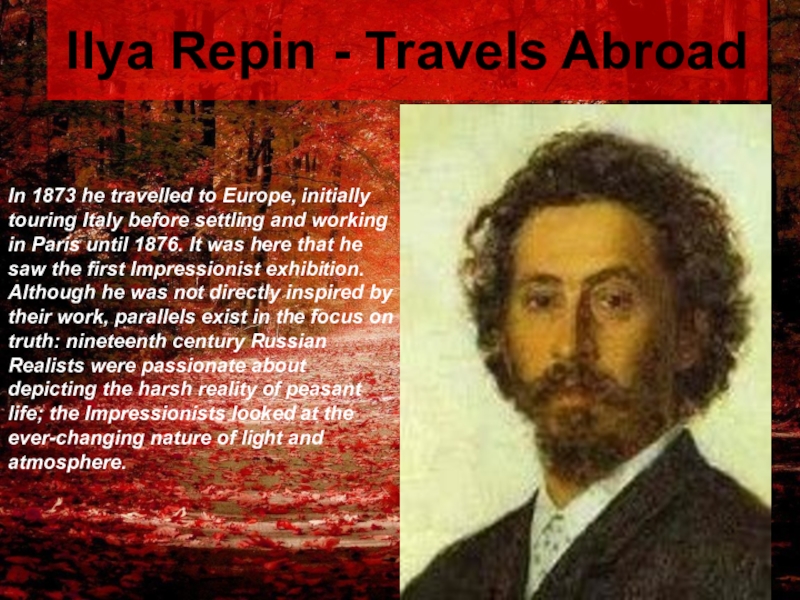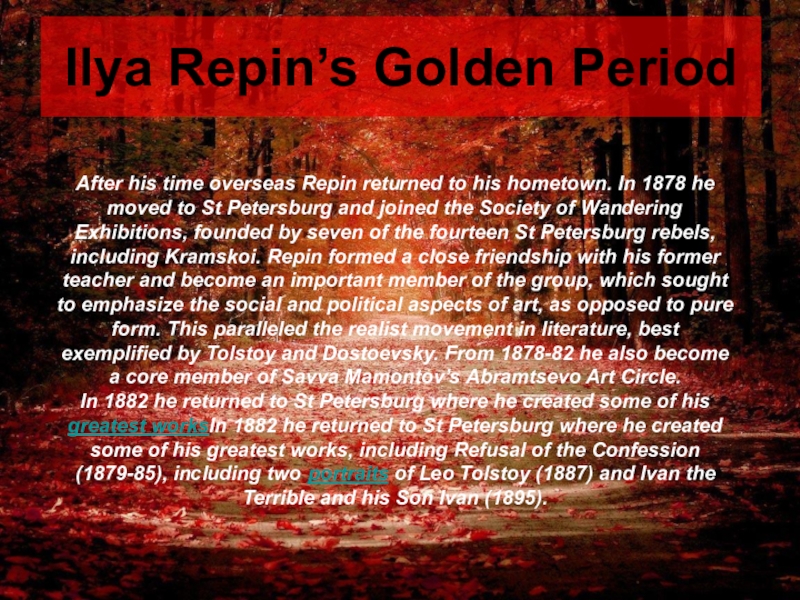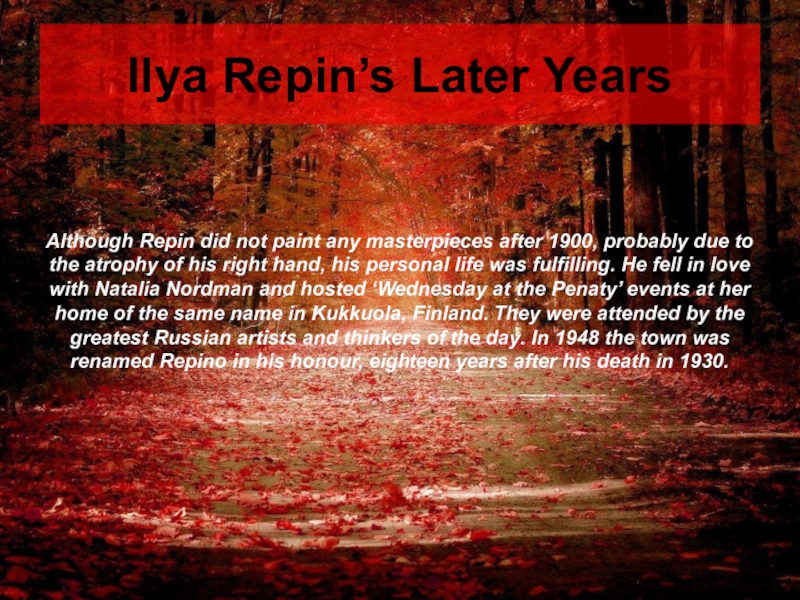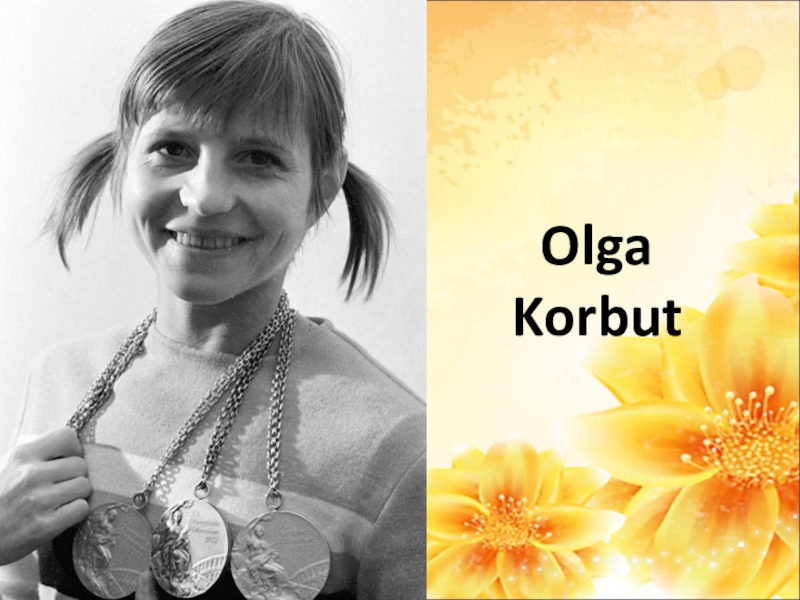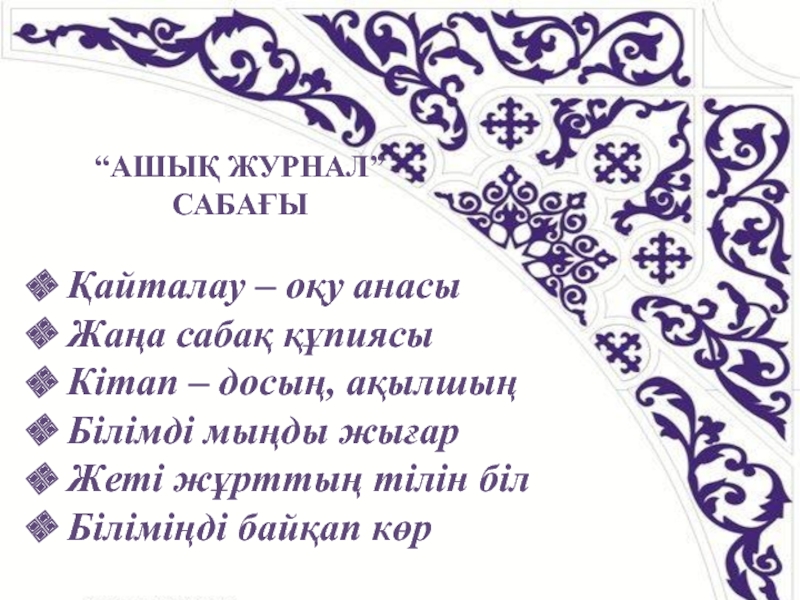Слайд 2
Edgar Degas
Birth name Hilaire-Germain-Edgar Degas Born 19 July 1834)
Paris France September
1917) (aged 83)
Paris, France Nationality French Field painting Sculpture Drawing Movement Impression Works The Bellelli Family (1858-1867)
Woman with Chrysanthemums (1865)
Chanteuse de Café (c.1878)
At the Milliner's (1882) Influenced Mary Cassat, Jain-Louis Forain Walter Sickert, Henri de Toulouse-Lautrec
Self-portrait (Degas au porte-fusain), 1855
Слайд 3Edgar Degas (19 July 1834 – 27 September 1917), born Hilaire-Germain-Edgar
De Gas was a French artist famous for his work in paintingEdgar Degas (19 July 1834 – 27 September 1917), born Hilaire-Germain-Edgar De Gas was a French artist famous for his work in painting, sculptureEdgar Degas (19 July 1834 – 27 September 1917), born Hilaire-Germain-Edgar De Gas was a French artist famous for his work in painting, sculpture, printmakingEdgar Degas (19 July 1834 – 27 September 1917), born Hilaire-Germain-Edgar De Gas was a French artist famous for his work in painting, sculpture, printmaking and drawingEdgar Degas (19 July 1834 – 27 September 1917), born Hilaire-Germain-Edgar De Gas was a French artist famous for his work in painting, sculpture, printmaking and drawing. He is regarded as one of the founders of ImpressionismEdgar Degas (19 July 1834 – 27 September 1917), born Hilaire-Germain-Edgar De Gas was a French artist famous for his work in painting, sculpture, printmaking and drawing. He is regarded as one of the founders of Impressionism although he rejected the term, and preferred to be called a realist. A superb draughtsmanEdgar Degas (19 July 1834 – 27 September 1917), born Hilaire-Germain-Edgar De Gas was a French artist famous for his work in painting, sculpture, printmaking and drawing. He is regarded as one of the founders of Impressionism although he rejected the term, and preferred to be called a realist. A superb draughtsman, he is especially identified with the subject of the dance, and over half his works depict dancers. These display his mastery in the depiction of movement, as do his racecourse subjects and female nudesEdgar Degas (19 July 1834 – 27 September 1917), born Hilaire-Germain-Edgar De Gas was a French artist famous for his work in painting, sculpture, printmaking and drawing. He is regarded as one of the founders of Impressionism although he rejected the term, and preferred to be called a realist. A superb draughtsman, he is especially identified with the subject of the dance, and over half his works depict dancers. These display his mastery in the depiction of movement, as do his racecourse subjects and female nudes. His portraits are notable for their psychological complexity and depiction of human isolation.
Early in his career, he wanted to be a history painter, a calling for which he was well prepared by his rigorous academic training and close study of classic art. In his early thirties, he changed course, and by bringing the traditional methods of a history painter to bear on contemporary subject matter, he became a classical painter of modern life.
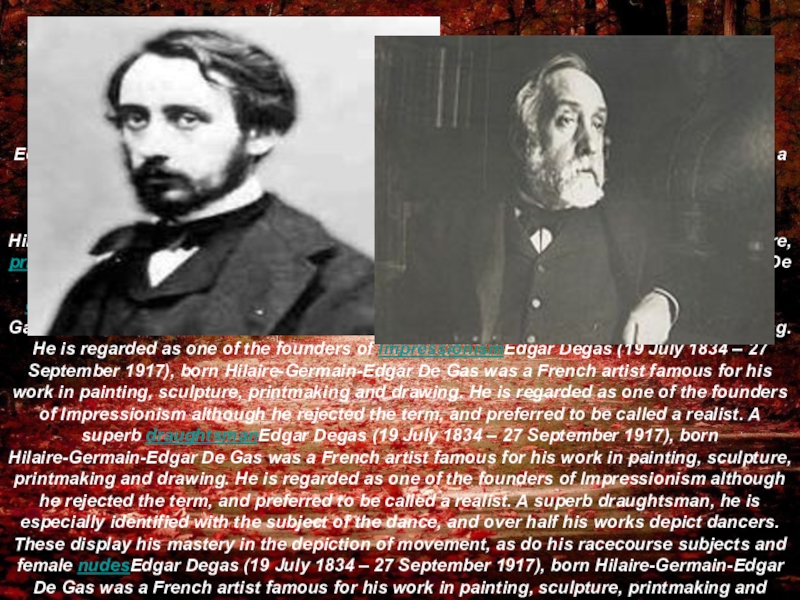
Слайд 4Degas was born in ParisDegas was born in Paris, France, the
eldest of five children of Célestine Musson De Gas and Augustin De Gas, a bankerDegas was born in Paris, France, the eldest of five children of Célestine Musson De Gas and Augustin De Gas, a banker. The family was moderately wealthy. His mother died when Degas was thirteen, after which his father and grandfather were the main influences on his early life. At age eleven, Degas (in adulthood he abandoned the more pretentious spelling of the family name)[4]Degas was born in Paris, France, the eldest of five children of Célestine Musson De Gas and Augustin De Gas, a banker. The family was moderately wealthy. His mother died when Degas was thirteen, after which his father and grandfather were the main influences on his early life. At age eleven, Degas (in adulthood he abandoned the more pretentious spelling of the family name)[4] began his schooling with enrollment in the Lycée Louis-le-Grand, graduating in 1853 with a baccalauréat in literature.
Degas began to paint early in his life. By eighteen, he had turned a room in his home into an artist's studio, and in 1853 he registered as a copyist in the LouvreDegas began to paint early in his life. By eighteen, he had turned a room in his home into an artist's studio, and in 1853 he registered as a copyist in the Louvre. His father, however, expected him to go to law schoolDegas began to paint early in his life. By eighteen, he had turned a room in his home into an artist's studio, and in 1853 he registered as a copyist in the Louvre. His father, however, expected him to go to law school. Degas duly registered at the Faculty of Law of the University of ParisDegas began to paint early in his life. By eighteen, he had turned a room in his home into an artist's studio, and in 1853 he registered as a copyist in the Louvre. His father, however, expected him to go to law school. Degas duly registered at the Faculty of Law of the University of Paris in November 1853, but made little effort at his studies there. In 1855, Degas met Jean Auguste Dominique IngresDegas began to paint early in his life. By eighteen, he had turned a room in his home into an artist's studio, and in 1853 he registered as a copyist in the Louvre. His father, however, expected him to go to law school. Degas duly registered at the Faculty of Law of the University of Paris in November 1853, but made little effort at his studies there. In 1855, Degas met Jean Auguste Dominique Ingres, whom he revered, and whose advice he never forgot: "Draw lines, young man, and still more lines, both from life and from memory, and you will become a good artist."[5]Degas began to paint early in his life. By eighteen, he had turned a room in his home into an artist's studio, and in 1853 he registered as a copyist in the Louvre. His father, however, expected him to go to law school. Degas duly registered at the Faculty of Law of the University of Paris in November 1853, but made little effort at his studies there. In 1855, Degas met Jean Auguste Dominique Ingres, whom he revered, and whose advice he never forgot: "Draw lines, young man, and still more lines, both from life and from memory, and you will become a good artist."[5] In April of that same year, Degas received admission to the École des Beaux-ArtsDegas began to paint early in his life. By eighteen, he had turned a room in his home into an artist's studio, and in 1853 he registered as a copyist in the Louvre. His father, however, expected him to go to law school. Degas duly registered at the Faculty of Law of the University of Paris in November 1853, but made little effort at his studies there. In 1855, Degas met Jean Auguste Dominique Ingres, whom he revered, and whose advice he never forgot: "Draw lines, young man, and still more lines, both from life and from memory, and you will become a good artist."[5] In April of that same year, Degas received admission to the École des Beaux-Arts, where he studied drawing with Louis LamotheDegas began to paint early in his life. By eighteen, he had turned a room in his home into an artist's studio, and in 1853 he registered as a copyist in the Louvre. His father, however, expected him to go to law school. Degas duly registered at the Faculty of Law of the University of Paris in November 1853, but made little effort at his studies there. In 1855, Degas met Jean Auguste Dominique Ingres, whom he revered, and whose advice he never forgot: "Draw lines, young man, and still more lines, both from life and from memory, and you will become a good artist."[5] In April of that same year, Degas received admission to the École des Beaux-Arts, where he studied drawing with Louis Lamothe, under whose guidance he flourished, following the style of Ingres.[6]Degas began to paint early in his life. By eighteen, he had turned a room in his home into an artist's studio, and in 1853 he registered as a copyist in the Louvre. His father, however, expected him to go to law school. Degas duly registered at the Faculty of Law of the University of Paris in November 1853, but made little effort at his studies there. In 1855, Degas met Jean Auguste Dominique Ingres, whom he revered, and whose advice he never forgot: "Draw lines, young man, and still more lines, both from life and from memory, and you will become a good artist."[5] In April of that same year, Degas received admission to the École des Beaux-Arts, where he studied drawing with Louis Lamothe, under whose guidance he flourished, following the style of Ingres.[6] In July 1856, Degas traveled to ItalyDegas began to paint early in his life. By eighteen, he had turned a room in his home into an artist's studio, and in 1853 he registered as a copyist in the Louvre. His father, however, expected him to go to law school. Degas duly registered at the Faculty of Law of the University of Paris in November 1853, but made little effort at his studies there. In 1855, Degas met Jean Auguste Dominique Ingres, whom he revered, and whose advice he never forgot: "Draw lines, young man, and still more lines, both from life and from memory, and you will become a good artist."[5] In April of that same year, Degas received admission to the École des Beaux-Arts, where he studied drawing with Louis Lamothe, under whose guidance he flourished, following the style of Ingres.[6] In July 1856, Degas traveled to Italy, where he would remain for the next three years. In 1858, while staying with his aunt's family in NaplesDegas began to paint early in his life. By eighteen, he had turned a room in his home into an artist's studio, and in 1853 he registered as a copyist in the Louvre. His father, however, expected him to go to law school. Degas duly registered at the Faculty of Law of the University of Paris in November 1853, but made little effort at his studies there. In 1855, Degas met Jean Auguste Dominique Ingres, whom he revered, and whose advice he never forgot: "Draw lines, young man, and still more lines, both from life and from memory, and you will become a good artist."[5] In April of that same year, Degas received admission to the École des Beaux-Arts, where he studied drawing with Louis Lamothe, under whose guidance he flourished, following the style of Ingres.[6] In July 1856, Degas traveled to Italy, where he would remain for the next three years. In 1858, while staying with his aunt's family in Naples, he made the first studies for his early masterpiece, The Bellelli FamilyDegas began to paint early in his life. By eighteen, he had turned a room in his home into an artist's studio, and in 1853 he registered as a copyist in the Louvre. His father, however, expected him to go to law school. Degas duly registered at the Faculty of Law of the University of Paris in November 1853, but made little effort at his studies there. In 1855, Degas met Jean Auguste Dominique Ingres, whom he revered, and whose advice he never forgot: "Draw lines, young man, and still more lines, both from life and from memory, and you will become a good artist."[5] In April of that same year, Degas received admission to the École des Beaux-Arts, where he studied drawing with Louis Lamothe, under whose guidance he flourished, following the style of Ingres.[6] In July 1856, Degas traveled to Italy, where he would remain for the next three years. In 1858, while staying with his aunt's family in Naples, he made the first studies for his early masterpiece, The Bellelli Family. He also drew and painted numerous copies after MichelangeloDegas began to paint early in his life. By eighteen, he had turned a room in his home into an artist's studio, and in 1853 he registered as a copyist in the Louvre. His father, however, expected him to go to law school. Degas duly registered at the Faculty of Law of the University of Paris in November 1853, but made little effort at his studies there. In 1855, Degas met Jean Auguste Dominique Ingres, whom he revered, and whose advice he never forgot: "Draw lines, young man, and still more lines, both from life and from memory, and you will become a good artist."[5] In April of that same year, Degas received admission to the École des Beaux-Arts, where he studied drawing with Louis Lamothe, under whose guidance he flourished, following the style of Ingres.[6] In July 1856, Degas traveled to Italy, where he would remain for the next three years. In 1858, while staying with his aunt's family in Naples, he made the first studies for his early masterpiece, The Bellelli Family. He also drew and painted numerous copies after Michelangelo, RaphaelDegas began to paint early in his life. By eighteen, he had turned a room in his home into an artist's studio, and in 1853 he registered as a copyist in the Louvre. His father, however, expected him to go to law school. Degas duly registered at the Faculty of Law of the University of Paris in November 1853, but made little effort at his studies there. In 1855, Degas met Jean Auguste Dominique Ingres, whom he revered, and whose advice he never forgot: "Draw lines, young man, and still more lines, both from life and from memory, and you will become a good artist."[5] In April of that same year, Degas received admission to the École des Beaux-Arts, where he studied drawing with Louis Lamothe, under whose guidance he flourished, following the style of Ingres.[6] In July 1856, Degas traveled to Italy, where he would remain for the next three years. In 1858, while staying with his aunt's family in Naples, he made the first studies for his early masterpiece, The Bellelli Family. He also drew and painted numerous copies after Michelangelo, Raphael, TitianDegas began to paint early in his life. By eighteen, he had turned a room in his home into an artist's studio, and in 1853 he registered as a copyist in the Louvre. His father, however, expected him to go to law school. Degas duly registered at the Faculty of Law of the University of Paris in November 1853, but made little effort at his studies there. In 1855, Degas met Jean Auguste Dominique Ingres, whom he revered, and whose advice he never forgot: "Draw lines, young man, and still more lines, both from life and from memory, and you will become a good artist."[5] In April of that same year, Degas received admission to the École des Beaux-Arts, where he studied drawing with Louis Lamothe, under whose guidance he flourished, following the style of Ingres.[6] In July 1856, Degas traveled to Italy, where he would remain for the next three years. In 1858, while staying with his aunt's family in Naples, he made the first studies for his early masterpiece, The Bellelli Family. He also drew and painted numerous copies after Michelangelo, Raphael, Titian, and other artists of the RenaissanceDegas began to paint early in his life. By eighteen, he had turned a room in his home into an artist's studio, and in 1853 he registered as a copyist in the Louvre. His father, however, expected him to go to law school. Degas duly registered at the Faculty of Law of the University of Paris in November 1853, but made little effort at his studies there. In 1855, Degas met Jean Auguste Dominique Ingres, whom he revered, and whose advice he never forgot: "Draw lines, young man, and still more lines, both from life and from memory, and you will become a good artist."[5] In April of that same year, Degas received admission to the École des Beaux-Arts, where he studied drawing with Louis Lamothe, under whose guidance he flourished, following the style of Ingres.[6] In July 1856, Degas traveled to Italy, where he would remain for the next three years. In 1858, while staying with his aunt's family in Naples, he made the first studies for his early masterpiece, The Bellelli Family. He also drew and painted numerous copies after Michelangelo, Raphael, Titian, and other artists of the Renaissance but, contrary to conventional practice, he usually selected from an altarpiece a detail that had caught his attention—a secondary figure, or a head which he treated as a portrait.[7]
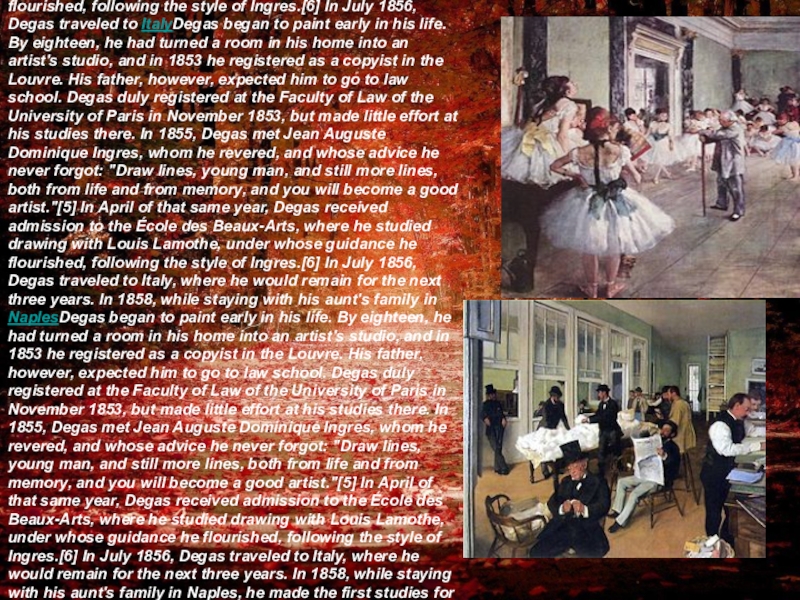
Слайд 5
Upon his return to France in 1859, Degas moved into a
Paris studio large enough to permit him to begin painting The Bellelli Family—an imposing canvas he intended for exhibition in the SalonUpon his return to France in 1859, Degas moved into a Paris studio large enough to permit him to begin painting The Bellelli Family—an imposing canvas he intended for exhibition in the Salon, although it remained unfinished until 1867. He also began work on several history paintingsUpon his return to France in 1859, Degas moved into a Paris studio large enough to permit him to begin painting The Bellelli Family—an imposing canvas he intended for exhibition in the Salon, although it remained unfinished until 1867. He also began work on several history paintings: Alexander and Bucephalus and The Daughter of Jephthah in 1859–60; Sémiramis Building Babylon in 1860; and Young Spartans around 1860.[8]Upon his return to France in 1859, Degas moved into a Paris studio large enough to permit him to begin painting The Bellelli Family—an imposing canvas he intended for exhibition in the Salon, although it remained unfinished until 1867. He also began work on several history paintings: Alexander and Bucephalus and The Daughter of Jephthah in 1859–60; Sémiramis Building Babylon in 1860; and Young Spartans around 1860.[8] In 1861, Degas visited his childhood friend Paul Valpinçon in NormandyUpon his return to France in 1859, Degas moved into a Paris studio large enough to permit him to begin painting The Bellelli Family—an imposing canvas he intended for exhibition in the Salon, although it remained unfinished until 1867. He also began work on several history paintings: Alexander and Bucephalus and The Daughter of Jephthah in 1859–60; Sémiramis Building Babylon in 1860; and Young Spartans around 1860.[8] In 1861, Degas visited his childhood friend Paul Valpinçon in Normandy, and made the earliest of his many studies of horses. He exhibited at the Salon for the first time in 1865, when the jury accepted his painting Scene of War in the Middle Ages, which attracted little attention.[9]Upon his return to France in 1859, Degas moved into a Paris studio large enough to permit him to begin painting The Bellelli Family—an imposing canvas he intended for exhibition in the Salon, although it remained unfinished until 1867. He also began work on several history paintings: Alexander and Bucephalus and The Daughter of Jephthah in 1859–60; Sémiramis Building Babylon in 1860; and Young Spartans around 1860.[8] In 1861, Degas visited his childhood friend Paul Valpinçon in Normandy, and made the earliest of his many studies of horses. He exhibited at the Salon for the first time in 1865, when the jury accepted his painting Scene of War in the Middle Ages, which attracted little attention.[9] Although he exhibited annually in the Salon during the next five years, he submitted no more history paintings, and his Steeplechase—The Fallen Jockey (Salon of 1866) signaled his growing commitment to contemporary subject matter. The change in his art was influenced primarily by the example of Édouard ManetUpon his return to France in 1859, Degas moved into a Paris studio large enough to permit him to begin painting The Bellelli Family—an imposing canvas he intended for exhibition in the Salon, although it remained unfinished until 1867. He also began work on several history paintings: Alexander and Bucephalus and The Daughter of Jephthah in 1859–60; Sémiramis Building Babylon in 1860; and Young Spartans around 1860.[8] In 1861, Degas visited his childhood friend Paul Valpinçon in Normandy, and made the earliest of his many studies of horses. He exhibited at the Salon for the first time in 1865, when the jury accepted his painting Scene of War in the Middle Ages, which attracted little attention.[9] Although he exhibited annually in the Salon during the next five years, he submitted no more history paintings, and his Steeplechase—The Fallen Jockey (Salon of 1866) signaled his growing commitment to contemporary subject matter. The change in his art was influenced primarily by the example of Édouard Manet, whom Degas had met in 1864 (while both were copying the same VelázquezUpon his return to France in 1859, Degas moved into a Paris studio large enough to permit him to begin painting The Bellelli Family—an imposing canvas he intended for exhibition in the Salon, although it remained unfinished until 1867. He also began work on several history paintings: Alexander and Bucephalus and The Daughter of Jephthah in 1859–60; Sémiramis Building Babylon in 1860; and Young Spartans around 1860.[8] In 1861, Degas visited his childhood friend Paul Valpinçon in Normandy, and made the earliest of his many studies of horses. He exhibited at the Salon for the first time in 1865, when the jury accepted his painting Scene of War in the Middle Ages, which attracted little attention.[9] Although he exhibited annually in the Salon during the next five years, he submitted no more history paintings, and his Steeplechase—The Fallen Jockey (Salon of 1866) signaled his growing commitment to contemporary subject matter. The change in his art was influenced primarily by the example of Édouard Manet, whom Degas had met in 1864 (while both were copying the same Velázquez portrait in the Louvre, according to a story that may be apocryphal).[10]
At the outbreak of the Franco-Prussian War in 1870, Degas enlisted in the National Guard, where his defense of Paris left him little time for painting. During rifle training his eyesight was found to be defective, and for the rest of his life his eye problems were a constant worry to him
Artistic career
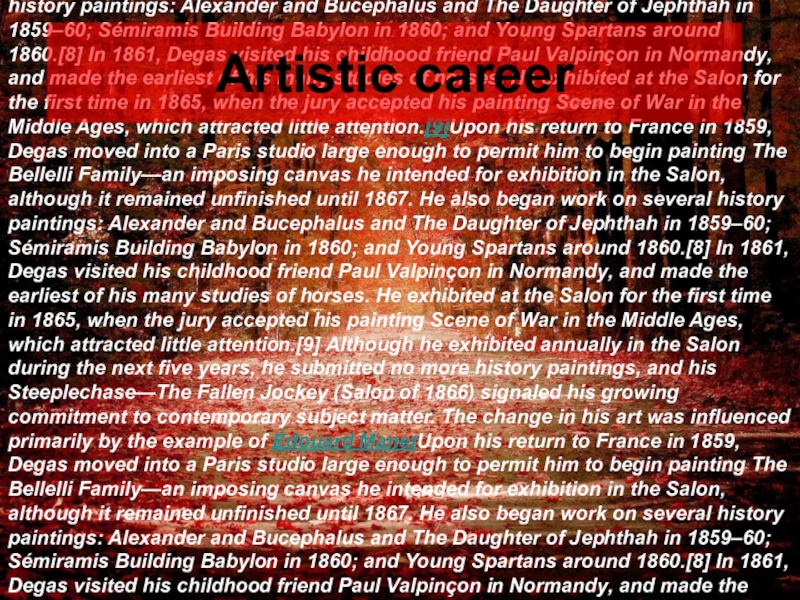
Слайд 6Musicians in the Orchestra, 1872,
L'Absinthe, 1876, oil on canvas
Слайд 7After the war, in 1872, Degas began an extended stay in
New Orleans, LouisianaAfter the war, in 1872, Degas began an extended stay in New Orleans, Louisiana, where his brother René and a number of other relatives lived. Staying in a house on Esplanade AvenueAfter the war, in 1872, Degas began an extended stay in New Orleans, Louisiana, where his brother René and a number of other relatives lived. Staying in a house on Esplanade Avenue, Degas produced a number of works, many depicting family members. One of Degas's New Orleans works, A Cotton Office in New OrleansAfter the war, in 1872, Degas began an extended stay in New Orleans, Louisiana, where his brother René and a number of other relatives lived. Staying in a house on Esplanade Avenue, Degas produced a number of works, many depicting family members. One of Degas's New Orleans works, A Cotton Office in New Orleans, garnered favorable attention back in France, and was his only work purchased by a museum (that of Pau) during his lifetime.
Degas returned to Paris in 1873. The following year his father died, and in the subsequent settling of the estate it was discovered that Degas's brother René had amassed enormous business debts. To preserve the family name, Degas was forced to sell his house and a collection of art he had inherited. Dependent for the first time in his life on sales of his artwork for income, he produced much of his greatest work during the decade beginning in 1874. By now thoroughly disenchanted with the Salon, Degas joined forces with a group of young artists who were intent upon organizing an independent exhibiting society. The first of their exhibitions, which were quickly dubbed Impressionist Exhibitions, was in 1874.
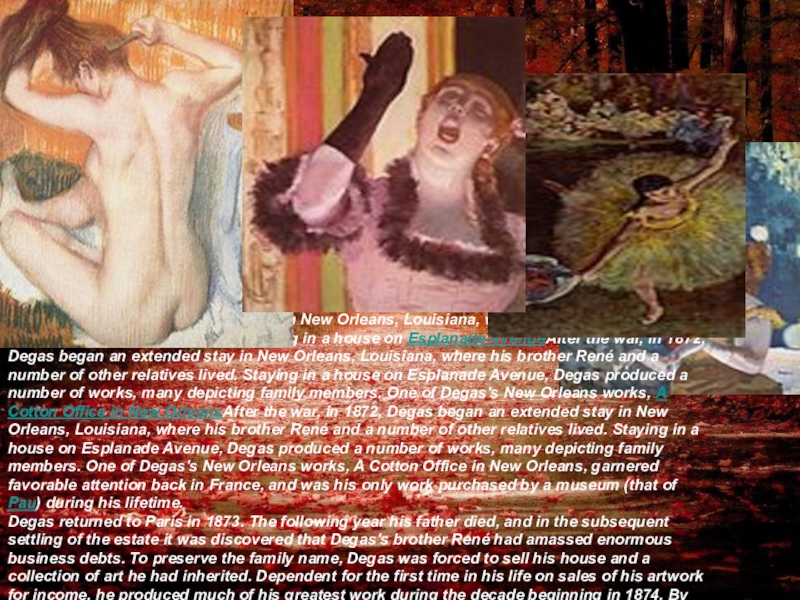
Слайд 8The Impressionists subsequently held seven additional shows, the last in 1886.
Degas took a leading role in organizing the exhibitions, and showed his work in all but one of them, despite his persistent conflicts with others in the group. He had little in common with MonetThe Impressionists subsequently held seven additional shows, the last in 1886. Degas took a leading role in organizing the exhibitions, and showed his work in all but one of them, despite his persistent conflicts with others in the group. He had little in common with Monet and the other landscape painters, whom he mocked for painting outdoors. Conservative in his social attitudes, he abhorred the scandal created by the exhibitions, as well as the publicity and advertising that his colleagues sought. He bitterly rejected the label Impressionist that the press had created and popularized, and his insistence on including non-Impressionist artists such as Jean-Louis ForainThe Impressionists subsequently held seven additional shows, the last in 1886. Degas took a leading role in organizing the exhibitions, and showed his work in all but one of them, despite his persistent conflicts with others in the group. He had little in common with Monet and the other landscape painters, whom he mocked for painting outdoors. Conservative in his social attitudes, he abhorred the scandal created by the exhibitions, as well as the publicity and advertising that his colleagues sought. He bitterly rejected the label Impressionist that the press had created and popularized, and his insistence on including non-Impressionist artists such as Jean-Louis Forain and Jean-François RaffaëlliThe Impressionists subsequently held seven additional shows, the last in 1886. Degas took a leading role in organizing the exhibitions, and showed his work in all but one of them, despite his persistent conflicts with others in the group. He had little in common with Monet and the other landscape painters, whom he mocked for painting outdoors. Conservative in his social attitudes, he abhorred the scandal created by the exhibitions, as well as the publicity and advertising that his colleagues sought. He bitterly rejected the label Impressionist that the press had created and popularized, and his insistence on including non-Impressionist artists such as Jean-Louis Forain and Jean-François Raffaëlli in their exhibitions created rancor within the group, contributing to their eventual disbanding in 1886. As his financial situation improved through sales of his own work, he was able to indulge his passion for collecting works by artists he admired: old masters such as El GrecoThe Impressionists subsequently held seven additional shows, the last in 1886. Degas took a leading role in organizing the exhibitions, and showed his work in all but one of them, despite his persistent conflicts with others in the group. He had little in common with Monet and the other landscape painters, whom he mocked for painting outdoors. Conservative in his social attitudes, he abhorred the scandal created by the exhibitions, as well as the publicity and advertising that his colleagues sought. He bitterly rejected the label Impressionist that the press had created and popularized, and his insistence on including non-Impressionist artists such as Jean-Louis Forain and Jean-François Raffaëlli in their exhibitions created rancor within the group, contributing to their eventual disbanding in 1886. As his financial situation improved through sales of his own work, he was able to indulge his passion for collecting works by artists he admired: old masters such as El Greco and such contemporaries as ManetThe Impressionists subsequently held seven additional shows, the last in 1886. Degas took a leading role in organizing the exhibitions, and showed his work in all but one of them, despite his persistent conflicts with others in the group. He had little in common with Monet and the other landscape painters, whom he mocked for painting outdoors. Conservative in his social attitudes, he abhorred the scandal created by the exhibitions, as well as the publicity and advertising that his colleagues sought. He bitterly rejected the label Impressionist that the press had created and popularized, and his insistence on including non-Impressionist artists such as Jean-Louis Forain and Jean-François Raffaëlli in their exhibitions created rancor within the group, contributing to their eventual disbanding in 1886. As his financial situation improved through sales of his own work, he was able to indulge his passion for collecting works by artists he admired: old masters such as El Greco and such contemporaries as Manet, PissarroThe Impressionists subsequently held seven additional shows, the last in 1886. Degas took a leading role in organizing the exhibitions, and showed his work in all but one of them, despite his persistent conflicts with others in the group. He had little in common with Monet and the other landscape painters, whom he mocked for painting outdoors. Conservative in his social attitudes, he abhorred the scandal created by the exhibitions, as well as the publicity and advertising that his colleagues sought. He bitterly rejected the label Impressionist that the press had created and popularized, and his insistence on including non-Impressionist artists such as Jean-Louis Forain and Jean-François Raffaëlli in their exhibitions created rancor within the group, contributing to their eventual disbanding in 1886. As his financial situation improved through sales of his own work, he was able to indulge his passion for collecting works by artists he admired: old masters such as El Greco and such contemporaries as Manet, Pissarro, CézanneThe Impressionists subsequently held seven additional shows, the last in 1886. Degas took a leading role in organizing the exhibitions, and showed his work in all but one of them, despite his persistent conflicts with others in the group. He had little in common with Monet and the other landscape painters, whom he mocked for painting outdoors. Conservative in his social attitudes, he abhorred the scandal created by the exhibitions, as well as the publicity and advertising that his colleagues sought. He bitterly rejected the label Impressionist that the press had created and popularized, and his insistence on including non-Impressionist artists such as Jean-Louis Forain and Jean-François Raffaëlli in their exhibitions created rancor within the group, contributing to their eventual disbanding in 1886. As his financial situation improved through sales of his own work, he was able to indulge his passion for collecting works by artists he admired: old masters such as El Greco and such contemporaries as Manet, Pissarro, Cézanne, GauguinThe Impressionists subsequently held seven additional shows, the last in 1886. Degas took a leading role in organizing the exhibitions, and showed his work in all but one of them, despite his persistent conflicts with others in the group. He had little in common with Monet and the other landscape painters, whom he mocked for painting outdoors. Conservative in his social attitudes, he abhorred the scandal created by the exhibitions, as well as the publicity and advertising that his colleagues sought. He bitterly rejected the label Impressionist that the press had created and popularized, and his insistence on including non-Impressionist artists such as Jean-Louis Forain and Jean-François Raffaëlli in their exhibitions created rancor within the group, contributing to their eventual disbanding in 1886. As his financial situation improved through sales of his own work, he was able to indulge his passion for collecting works by artists he admired: old masters such as El Greco and such contemporaries as Manet, Pissarro, Cézanne, Gauguin, and Van GoghThe Impressionists subsequently held seven additional shows, the last in 1886. Degas took a leading role in organizing the exhibitions, and showed his work in all but one of them, despite his persistent conflicts with others in the group. He had little in common with Monet and the other landscape painters, whom he mocked for painting outdoors. Conservative in his social attitudes, he abhorred the scandal created by the exhibitions, as well as the publicity and advertising that his colleagues sought. He bitterly rejected the label Impressionist that the press had created and popularized, and his insistence on including non-Impressionist artists such as Jean-Louis Forain and Jean-François Raffaëlli in their exhibitions created rancor within the group, contributing to their eventual disbanding in 1886. As his financial situation improved through sales of his own work, he was able to indulge his passion for collecting works by artists he admired: old masters such as El Greco and such contemporaries as Manet, Pissarro, Cézanne, Gauguin, and Van Gogh. Three artists he idolized, IngresThe Impressionists subsequently held seven additional shows, the last in 1886. Degas took a leading role in organizing the exhibitions, and showed his work in all but one of them, despite his persistent conflicts with others in the group. He had little in common with Monet and the other landscape painters, whom he mocked for painting outdoors. Conservative in his social attitudes, he abhorred the scandal created by the exhibitions, as well as the publicity and advertising that his colleagues sought. He bitterly rejected the label Impressionist that the press had created and popularized, and his insistence on including non-Impressionist artists such as Jean-Louis Forain and Jean-François Raffaëlli in their exhibitions created rancor within the group, contributing to their eventual disbanding in 1886. As his financial situation improved through sales of his own work, he was able to indulge his passion for collecting works by artists he admired: old masters such as El Greco and such contemporaries as Manet, Pissarro, Cézanne, Gauguin, and Van Gogh. Three artists he idolized, Ingres, DelacroixThe Impressionists subsequently held seven additional shows, the last in 1886. Degas took a leading role in organizing the exhibitions, and showed his work in all but one of them, despite his persistent conflicts with others in the group. He had little in common with Monet and the other landscape painters, whom he mocked for painting outdoors. Conservative in his social attitudes, he abhorred the scandal created by the exhibitions, as well as the publicity and advertising that his colleagues sought. He bitterly rejected the label Impressionist that the press had created and popularized, and his insistence on including non-Impressionist artists such as Jean-Louis Forain and Jean-François Raffaëlli in their exhibitions created rancor within the group, contributing to their eventual disbanding in 1886. As his financial situation improved through sales of his own work, he was able to indulge his passion for collecting works by artists he admired: old masters such as El Greco and such contemporaries as Manet, Pissarro, Cézanne, Gauguin, and Van Gogh. Three artists he idolized, Ingres, Delacroix, and DaumierThe Impressionists subsequently held seven additional shows, the last in 1886. Degas took a leading role in organizing the exhibitions, and showed his work in all but one of them, despite his persistent conflicts with others in the group. He had little in common with Monet and the other landscape painters, whom he mocked for painting outdoors. Conservative in his social attitudes, he abhorred the scandal created by the exhibitions, as well as the publicity and advertising that his colleagues sought. He bitterly rejected the label Impressionist that the press had created and popularized, and his insistence on including non-Impressionist artists such as Jean-Louis Forain and Jean-François Raffaëlli in their exhibitions created rancor within the group, contributing to their eventual disbanding in 1886. As his financial situation improved through sales of his own work, he was able to indulge his passion for collecting works by artists he admired: old masters such as El Greco and such contemporaries as Manet, Pissarro, Cézanne, Gauguin, and Van Gogh. Three artists he idolized, Ingres, Delacroix, and Daumier, were especially well represented in his collection. In the late 1880s, Degas also developed a passion for photographyThe Impressionists subsequently held seven additional shows, the last in 1886. Degas took a leading role in organizing the exhibitions, and showed his work in all but one of them, despite his persistent conflicts with others in the group. He had little in common with Monet and the other landscape painters, whom he mocked for painting outdoors. Conservative in his social attitudes, he abhorred the scandal created by the exhibitions, as well as the publicity and advertising that his colleagues sought. He bitterly rejected the label Impressionist that the press had created and popularized, and his insistence on including non-Impressionist artists such as Jean-Louis Forain and Jean-François Raffaëlli in their exhibitions created rancor within the group, contributing to their eventual disbanding in 1886. As his financial situation improved through sales of his own work, he was able to indulge his passion for collecting works by artists he admired: old masters such as El Greco and such contemporaries as Manet, Pissarro, Cézanne, Gauguin, and Van Gogh. Three artists he idolized, Ingres, Delacroix, and Daumier, were especially well represented in his collection. In the late 1880s, Degas also developed a passion for photography. He photographed many of his friends, often by lamplight, as in his double portrait of RenoirThe Impressionists subsequently held seven additional shows, the last in 1886. Degas took a leading role in organizing the exhibitions, and showed his work in all but one of them, despite his persistent conflicts with others in the group. He had little in common with Monet and the other landscape painters, whom he mocked for painting outdoors. Conservative in his social attitudes, he abhorred the scandal created by the exhibitions, as well as the publicity and advertising that his colleagues sought. He bitterly rejected the label Impressionist that the press had created and popularized, and his insistence on including non-Impressionist artists such as Jean-Louis Forain and Jean-François Raffaëlli in their exhibitions created rancor within the group, contributing to their eventual disbanding in 1886. As his financial situation improved through sales of his own work, he was able to indulge his passion for collecting works by artists he admired: old masters such as El Greco and such contemporaries as Manet, Pissarro, Cézanne, Gauguin, and Van Gogh. Three artists he idolized, Ingres, Delacroix, and Daumier, were especially well represented in his collection. In the late 1880s, Degas also developed a passion for photography. He photographed many of his friends, often by lamplight, as in his double portrait of Renoir and Mallarmê. Other photographs, depicting dancers and nudes, were used for reference in some of Degas's drawings and paintings
As the years passed, Degas became isolated, due in part to his belief that a painter could have no personal life. The Dreyfus AffairAs the years passed, Degas became isolated, due in part to his belief that a painter could have no personal life. The Dreyfus Affair controversy brought his anti-Semitic leanings to the fore and he broke with all his Jewish friends. His argumentative nature was deplored by Renoir, who said of him: "What a creature he was, that Degas! All his friends had to leave him; I was one of the last to go, but even I couldn't stay till the end.
The Spanish Dance, c. 1885 (bronze cast 1921), bronzeThe Spanish Dance, c. 1885 (bronze cast 1921), bronze, 46.3 x 14.3 cm, Ackland Art Museum
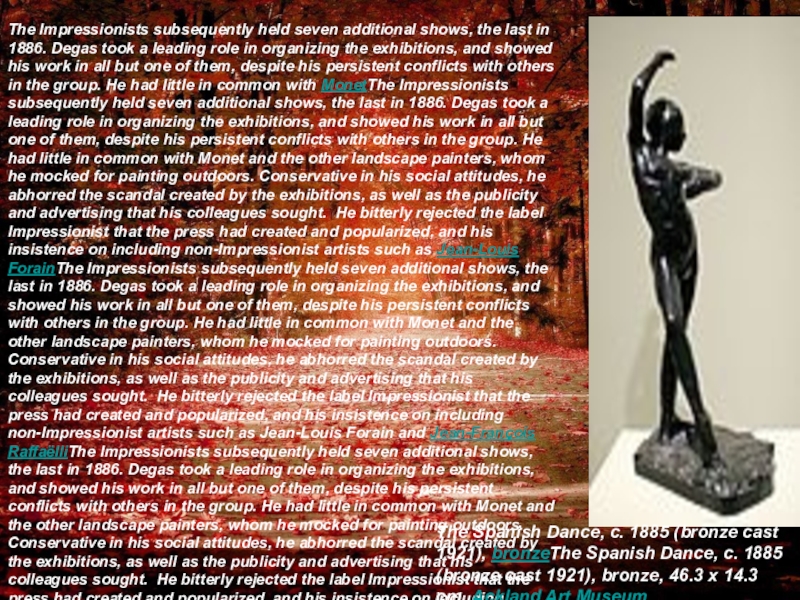
Слайд 9Sculpture
Degas's only showing of sculpture during his life took place
in 1881 when he exhibited The Little Fourteen Year Old Dancer, only shown again in 1920; the rest of the sculptural works remained private until a posthumous exhibition in 1918. Degas scholars have agreed that the sculptures were not created as aids to painting, although the artist habitually explored ways of linking graphic art and oil painting, drawing and pastel, sculpture and photography. Degas assigned the same significance to sculpture as to drawing: "Drawing is a way of thinking, modelling another".[28]
After Degas's death, his heirs found in his studio 150 wax sculptures, many in disrepair. They consulted foundry owner Adrien Hébrard, who concluded that 74 of the waxes could be cast in bronze. It is assumed that, except for the Little Dancer Aged Fourteen, all Degas bronzes worldwide are cast from surmoulages (i.e., cast from bronze masters). A surmoulage bronze is a bit smaller, and shows less surface detail, than its original bronze mold. The Hébrard Foundry cast the bronzes from 1919–1936, and closed down in 1937, shortly before Hébrard's death.
Little Dancer of Fourteen Years,
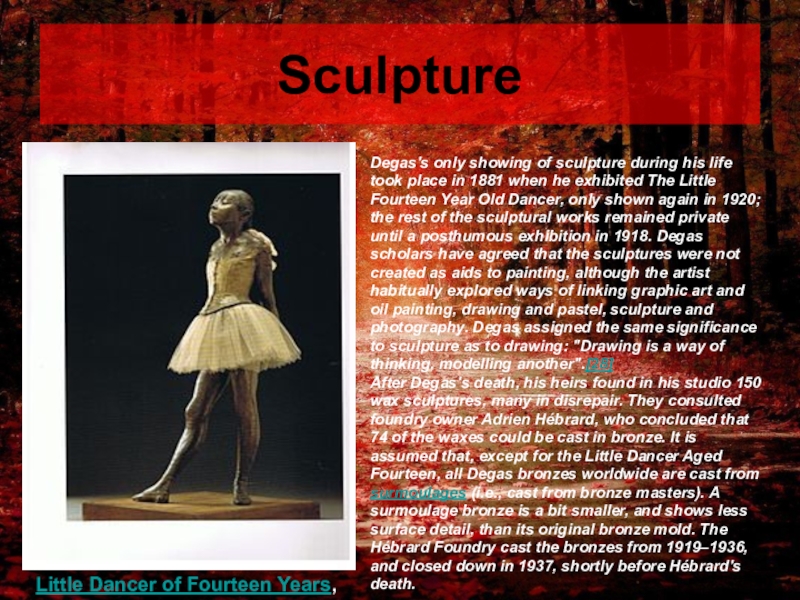
Слайд 10In 2004, a previously unknown cache of 73 plaster casts created
from wax originals sculpted by Degas was discovered. Although not previously catalogued, the casts were consistent with the 73 originals that Degas’s heirs gave to Hébrard Foundry in 1918. Art scholars are not in agreement as to what these casts actually are.[Walter F. Maibaum, an authority on 19th and 20th century European art, said: “The moment I gazed upon these remarkable plasters I instantly knew that everything that had been written about Degas’ sculptures in the past had to be reconsidered”. After examining them, Dr. Gregory Hedberg, Director of European Art for Hirschl and Adler Galleries in New York, concluded that the entire group of plasters were made during Degas’s lifetime between 1887 and 1912 by the artist’s close friend Albert Bartholomé whom he entrusted with the task. It appears, from their condition and provenance, that no bronzes were ever cast from these 73 plasters.
Plans to cast the newly discovered Degas sculptures, which differ in the rendering of details from the Hébrard casts, have created disagreement among Degas scholars and admirers, some of whom are reserving judgment regarding the authenticity of the plasters
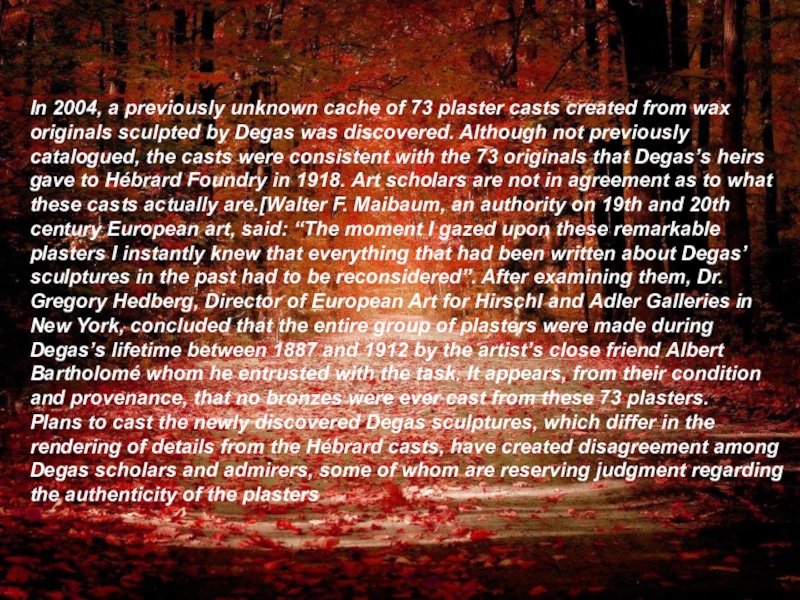
Слайд 11Personality and politics
Degas, who believed that "the artist must live
alone, and his private life must remain unknown",[42]Degas, who believed that "the artist must live alone, and his private life must remain unknown",[42] lived an outwardly uneventful life. In company he was known for his wit, which could often be cruel. He was characterized as an "old curmudgeon" by the novelist George MooreDegas, who believed that "the artist must live alone, and his private life must remain unknown",[42] lived an outwardly uneventful life. In company he was known for his wit, which could often be cruel. He was characterized as an "old curmudgeon" by the novelist George Moore,[42]Degas, who believed that "the artist must live alone, and his private life must remain unknown",[42] lived an outwardly uneventful life. In company he was known for his wit, which could often be cruel. He was characterized as an "old curmudgeon" by the novelist George Moore,[42] and he deliberately cultivated his reputation as a misanthropic bachelor.[19]Degas, who believed that "the artist must live alone, and his private life must remain unknown",[42] lived an outwardly uneventful life. In company he was known for his wit, which could often be cruel. He was characterized as an "old curmudgeon" by the novelist George Moore,[42] and he deliberately cultivated his reputation as a misanthropic bachelor.[19] Profoundly conservative in his political opinions, he opposed all social reforms and found little to admire in such technological advances as the telephoneDegas, who believed that "the artist must live alone, and his private life must remain unknown",[42] lived an outwardly uneventful life. In company he was known for his wit, which could often be cruel. He was characterized as an "old curmudgeon" by the novelist George Moore,[42] and he deliberately cultivated his reputation as a misanthropic bachelor.[19] Profoundly conservative in his political opinions, he opposed all social reforms and found little to admire in such technological advances as the telephone.[42]Degas, who believed that "the artist must live alone, and his private life must remain unknown",[42] lived an outwardly uneventful life. In company he was known for his wit, which could often be cruel. He was characterized as an "old curmudgeon" by the novelist George Moore,[42] and he deliberately cultivated his reputation as a misanthropic bachelor.[19] Profoundly conservative in his political opinions, he opposed all social reforms and found little to admire in such technological advances as the telephone.[42] He fired a model upon learning she was ProtestantDegas, who believed that "the artist must live alone, and his private life must remain unknown",[42] lived an outwardly uneventful life. In company he was known for his wit, which could often be cruel. He was characterized as an "old curmudgeon" by the novelist George Moore,[42] and he deliberately cultivated his reputation as a misanthropic bachelor.[19] Profoundly conservative in his political opinions, he opposed all social reforms and found little to admire in such technological advances as the telephone.[42] He fired a model upon learning she was Protestant.[42]Degas, who believed that "the artist must live alone, and his private life must remain unknown",[42] lived an outwardly uneventful life. In company he was known for his wit, which could often be cruel. He was characterized as an "old curmudgeon" by the novelist George Moore,[42] and he deliberately cultivated his reputation as a misanthropic bachelor.[19] Profoundly conservative in his political opinions, he opposed all social reforms and found little to admire in such technological advances as the telephone.[42] He fired a model upon learning she was Protestant.[42] Although Degas painted a number of Jewish subjects from 1865 to 1870, his anti-SemitismDegas, who believed that "the artist must live alone, and his private life must remain unknown",[42] lived an outwardly uneventful life. In company he was known for his wit, which could often be cruel. He was characterized as an "old curmudgeon" by the novelist George Moore,[42] and he deliberately cultivated his reputation as a misanthropic bachelor.[19] Profoundly conservative in his political opinions, he opposed all social reforms and found little to admire in such technological advances as the telephone.[42] He fired a model upon learning she was Protestant.[42] Although Degas painted a number of Jewish subjects from 1865 to 1870, his anti-Semitism became apparent by the mid 1870s. His 1879 painting At The Bourse is widely regarded as strongly anti-Semitic, with the facial features of the banker taken directly from the anti-Semitic cartoons rampant in Paris at the time.[43]
The Dreyfus AffairThe Dreyfus Affair, which divided Paris from the 1890s to the early 1900s, further intensified his anti-Semitism. By the mid 1890s, he had broken off relations with all of his Jewish friends,[18]The Dreyfus Affair, which divided Paris from the 1890s to the early 1900s, further intensified his anti-Semitism. By the mid 1890s, he had broken off relations with all of his Jewish friends,[18] publicly disavowed his previous friendships with Jewish artists, and refused to use models who he believed might be Jewish. He remained an outspoken anti-Semite and member of the anti-Semitic "Anti-Dreyfusards" until his death
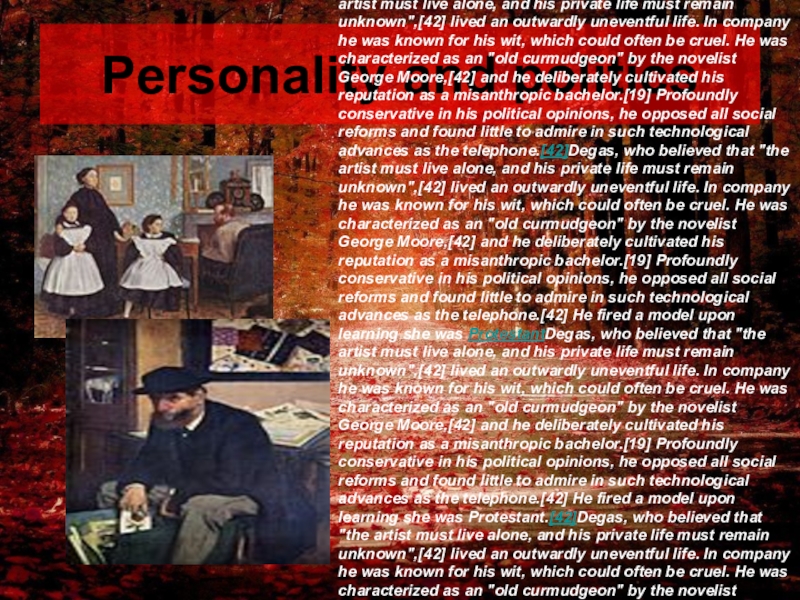
Слайд 12Eugène Delacroix
Eugène Delacroix (portrait by Nadar)
Слайд 13Ferdinand Victor Eugène Delacroix (26 April 1798 – 13 August 1863)
was a FrenchFerdinand Victor Eugène Delacroix (26 April 1798 – 13 August 1863) was a French RomanticFerdinand Victor Eugène Delacroix (26 April 1798 – 13 August 1863) was a French Romantic artist regarded from the outset of his career as the leader of the French Romantic school.[1]Ferdinand Victor Eugène Delacroix (26 April 1798 – 13 August 1863) was a French Romantic artist regarded from the outset of his career as the leader of the French Romantic school.[1] Delacroix's use of expressive brushstrokes and his study of the optical effects of colour profoundly shaped the work of the ImpressionistsFerdinand Victor Eugène Delacroix (26 April 1798 – 13 August 1863) was a French Romantic artist regarded from the outset of his career as the leader of the French Romantic school.[1] Delacroix's use of expressive brushstrokes and his study of the optical effects of colour profoundly shaped the work of the Impressionists, while his passion for the exotic inspired the artists of the SymbolistFerdinand Victor Eugène Delacroix (26 April 1798 – 13 August 1863) was a French Romantic artist regarded from the outset of his career as the leader of the French Romantic school.[1] Delacroix's use of expressive brushstrokes and his study of the optical effects of colour profoundly shaped the work of the Impressionists, while his passion for the exotic inspired the artists of the Symbolist movement. A fine lithographerFerdinand Victor Eugène Delacroix (26 April 1798 – 13 August 1863) was a French Romantic artist regarded from the outset of his career as the leader of the French Romantic school.[1] Delacroix's use of expressive brushstrokes and his study of the optical effects of colour profoundly shaped the work of the Impressionists, while his passion for the exotic inspired the artists of the Symbolist movement. A fine lithographer, Delacroix illustrated various works of William ShakespeareFerdinand Victor Eugène Delacroix (26 April 1798 – 13 August 1863) was a French Romantic artist regarded from the outset of his career as the leader of the French Romantic school.[1] Delacroix's use of expressive brushstrokes and his study of the optical effects of colour profoundly shaped the work of the Impressionists, while his passion for the exotic inspired the artists of the Symbolist movement. A fine lithographer, Delacroix illustrated various works of William Shakespeare, the Scottish writer Walter ScottFerdinand Victor Eugène Delacroix (26 April 1798 – 13 August 1863) was a French Romantic artist regarded from the outset of his career as the leader of the French Romantic school.[1] Delacroix's use of expressive brushstrokes and his study of the optical effects of colour profoundly shaped the work of the Impressionists, while his passion for the exotic inspired the artists of the Symbolist movement. A fine lithographer, Delacroix illustrated various works of William Shakespeare, the Scottish writer Walter Scott and the German writer Johann Wolfgang von Goethe.
In contrast to the NeoclassicalIn contrast to the Neoclassical perfectionism of his chief rival IngresIn contrast to the Neoclassical perfectionism of his chief rival Ingres, Delacroix took for his inspiration the art of RubensIn contrast to the Neoclassical perfectionism of his chief rival Ingres, Delacroix took for his inspiration the art of Rubens and painters of the Venetian RenaissanceIn contrast to the Neoclassical perfectionism of his chief rival Ingres, Delacroix took for his inspiration the art of Rubens and painters of the Venetian Renaissance, with an attendant emphasis on colour and movement rather than clarity of outline and carefully modeled form. Dramatic and romantic content characterized the central themes of his maturity, and led him not to the classical models of Greek and Roman art, but to travel in North Africa, in search of the exotic.[2]In contrast to the Neoclassical perfectionism of his chief rival Ingres, Delacroix took for his inspiration the art of Rubens and painters of the Venetian Renaissance, with an attendant emphasis on colour and movement rather than clarity of outline and carefully modeled form. Dramatic and romantic content characterized the central themes of his maturity, and led him not to the classical models of Greek and Roman art, but to travel in North Africa, in search of the exotic.[2] Friend and spiritual heir to Théodore GéricaultIn contrast to the Neoclassical perfectionism of his chief rival Ingres, Delacroix took for his inspiration the art of Rubens and painters of the Venetian Renaissance, with an attendant emphasis on colour and movement rather than clarity of outline and carefully modeled form. Dramatic and romantic content characterized the central themes of his maturity, and led him not to the classical models of Greek and Roman art, but to travel in North Africa, in search of the exotic.[2] Friend and spiritual heir to Théodore Géricault, Delacroix was also inspired by Lord ByronIn contrast to the Neoclassical perfectionism of his chief rival Ingres, Delacroix took for his inspiration the art of Rubens and painters of the Venetian Renaissance, with an attendant emphasis on colour and movement rather than clarity of outline and carefully modeled form. Dramatic and romantic content characterized the central themes of his maturity, and led him not to the classical models of Greek and Roman art, but to travel in North Africa, in search of the exotic.[2] Friend and spiritual heir to Théodore Géricault, Delacroix was also inspired by Lord Byron, with whom he shared a strong identification with the "forces of the sublime", of nature in often violent action.[3]
However, Delacroix was given neither to sentimentality nor bombast, and his Romanticism was that of an individualist. In the words of Baudelaire, "Delacroix was passionately in love with passion, but coldly determined to express passion as clearly as possible
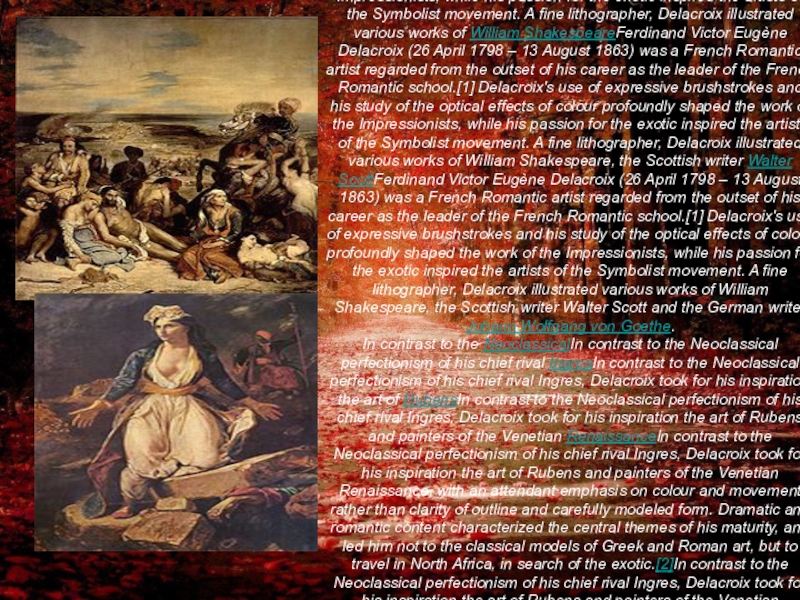
Слайд 14Early life
Delacroix was born at Charenton (Saint-Maurice, Val-de-MarneDelacroix was born
at Charenton (Saint-Maurice, Val-de-Marne), in Île-de-FranceDelacroix was born at Charenton (Saint-Maurice, Val-de-Marne), in Île-de-France, near Paris.
There is reason to believe that his father, Charles-François DelacroixThere is reason to believe that his father, Charles-François Delacroix, was infertile at the time of Eugène's conception and that his real father was TalleyrandThere is reason to believe that his father, Charles-François Delacroix, was infertile at the time of Eugène's conception and that his real father was Talleyrand, who was a friend of the family and successor of Charles Delacroix as Minister of Foreign Affairs, and whom the adult Eugène resembled in appearance and character Throughout his career as a painter, he was protected by Talleyrand, who served successively the RestorationThere is reason to believe that his father, Charles-François Delacroix, was infertile at the time of Eugène's conception and that his real father was Talleyrand, who was a friend of the family and successor of Charles Delacroix as Minister of Foreign Affairs, and whom the adult Eugène resembled in appearance and character Throughout his career as a painter, he was protected by Talleyrand, who served successively the Restoration and king Louis-PhilippeThere is reason to believe that his father, Charles-François Delacroix, was infertile at the time of Eugène's conception and that his real father was Talleyrand, who was a friend of the family and successor of Charles Delacroix as Minister of Foreign Affairs, and whom the adult Eugène resembled in appearance and character Throughout his career as a painter, he was protected by Talleyrand, who served successively the Restoration and king Louis-Philippe, and ultimately as ambassador of France in Great Britain, and later by Talleyrand's grandson, Charles Auguste Louis Joseph, duc de MornyThere is reason to believe that his father, Charles-François Delacroix, was infertile at the time of Eugène's conception and that his real father was Talleyrand, who was a friend of the family and successor of Charles Delacroix as Minister of Foreign Affairs, and whom the adult Eugène resembled in appearance and character Throughout his career as a painter, he was protected by Talleyrand, who served successively the Restoration and king Louis-Philippe, and ultimately as ambassador of France in Great Britain, and later by Talleyrand's grandson, Charles Auguste Louis Joseph, duc de Morny, half-brother of Napoleon IIIThere is reason to believe that his father, Charles-François Delacroix, was infertile at the time of Eugène's conception and that his real father was Talleyrand, who was a friend of the family and successor of Charles Delacroix as Minister of Foreign Affairs, and whom the adult Eugène resembled in appearance and character Throughout his career as a painter, he was protected by Talleyrand, who served successively the Restoration and king Louis-Philippe, and ultimately as ambassador of France in Great Britain, and later by Talleyrand's grandson, Charles Auguste Louis Joseph, duc de Morny, half-brother of Napoleon III and speaker of the French House of Commons. His father, Charles Delacroix, died in 1805, and his mother in 1814, leaving 16-year-old Eugene an orphan.
His early education was at the Lycée Louis-le-GrandHis early education was at the Lycée Louis-le-Grand, and at the Lycée Pierre CorneilleHis early education was at the Lycée Louis-le-Grand, and at the Lycée Pierre Corneille in Rouen[6 where he steeped himself in the classics and won awards for drawing. In 1815 he began his training with Pierre-Narcisse GuérinHis early education was at the Lycée Louis-le-Grand, and at the Lycée Pierre Corneille in Rouen[6 where he steeped himself in the classics and won awards for drawing. In 1815 he began his training with Pierre-Narcisse Guérin in the neoclassical style of Jacques-Louis DavidHis early education was at the Lycée Louis-le-Grand, and at the Lycée Pierre Corneille in Rouen[6 where he steeped himself in the classics and won awards for drawing. In 1815 he began his training with Pierre-Narcisse Guérin in the neoclassical style of Jacques-Louis David. An early church commission, The Virgin of the Harvest, (1819), displays a RaphaelHis early education was at the Lycée Louis-le-Grand, and at the Lycée Pierre Corneille in Rouen[6 where he steeped himself in the classics and won awards for drawing. In 1815 he began his training with Pierre-Narcisse Guérin in the neoclassical style of Jacques-Louis David. An early church commission, The Virgin of the Harvest, (1819), displays a Raphael-esque influence, but another such commission, The Virgin of the Sacred Heart, (1821), evidences a freer interpretation It precedes the influence of the more colorful and rich style of the Flemish painter Peter Paul RubensHis early education was at the Lycée Louis-le-Grand, and at the Lycée Pierre Corneille in Rouen[6 where he steeped himself in the classics and won awards for drawing. In 1815 he began his training with Pierre-Narcisse Guérin in the neoclassical style of Jacques-Louis David. An early church commission, The Virgin of the Harvest, (1819), displays a Raphael-esque influence, but another such commission, The Virgin of the Sacred Heart, (1821), evidences a freer interpretation It precedes the influence of the more colorful and rich style of the Flemish painter Peter Paul Rubens (1577–1640), and fellow French artist Théodore Géricault (1791–1824), whose works marked an introduction to Romanticism in art.
The impact of Géricault's The Raft of the MedusaThe impact of Géricault's The Raft of the Medusa was profound, and stimulated Delacroix to produce his first major painting, The Barque of DanteThe impact of Géricault's The Raft of the Medusa was profound, and stimulated Delacroix to produce his first major painting, The Barque of Dante, which was accepted by the Paris SalonThe impact of Géricault's The Raft of the Medusa was profound, and stimulated Delacroix to produce his first major painting, The Barque of Dante, which was accepted by the Paris Salon in 1822. The work caused a sensation, and was largely derided by the public and officialdom, yet was purchased by the State for the Luxembourg Galleries; the pattern of widespread opposition to his work, countered by a vigorous, enlightened support, would continue throughout his life. Two years later he again achieved popular success for his The Massacre at Chios.
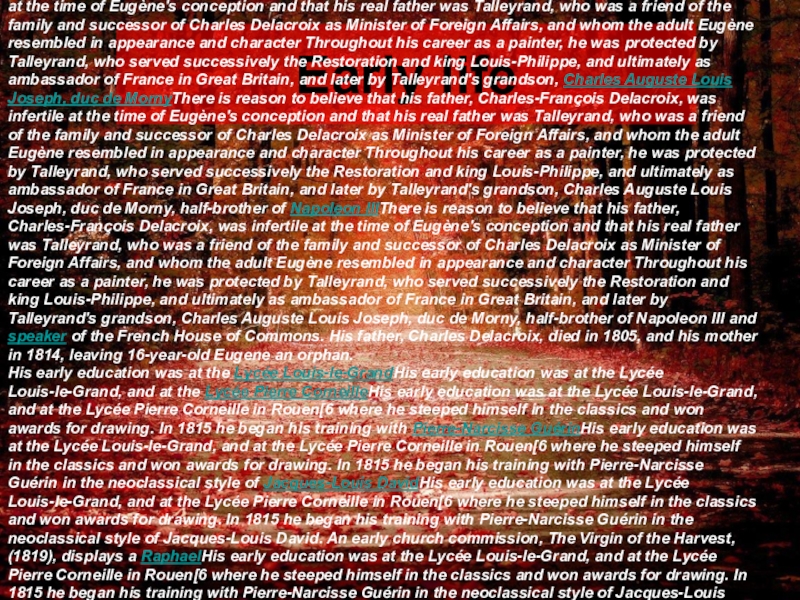
Слайд 16Liberty Leading the PeopleLiberty Leading the People (1830), Louvre
Delacroix's most influential
work came in 1830 with the painting Liberty Leading the People, which for choice of subject and technique highlights the differences between the romantic approach and the neoclassical style. Less obviously, it also differs from the Romanticism of Géricault and the Raft of the Medusa.
The French government bought the painting but officials deemed its glorification of liberty too inflammatory and removed it from public view. Nonetheless, Delacroix still received many government commissions for murals and ceiling paintings. He seems to have been trying to represent the spirit and the character of the people,[13]The French government bought the painting but officials deemed its glorification of liberty too inflammatory and removed it from public view. Nonetheless, Delacroix still received many government commissions for murals and ceiling paintings. He seems to have been trying to represent the spirit and the character of the people,[13] rather than glorify the actual event, a revolutionThe French government bought the painting but officials deemed its glorification of liberty too inflammatory and removed it from public view. Nonetheless, Delacroix still received many government commissions for murals and ceiling paintings. He seems to have been trying to represent the spirit and the character of the people,[13] rather than glorify the actual event, a revolution against King Charles XThe French government bought the painting but officials deemed its glorification of liberty too inflammatory and removed it from public view. Nonetheless, Delacroix still received many government commissions for murals and ceiling paintings. He seems to have been trying to represent the spirit and the character of the people,[13] rather than glorify the actual event, a revolution against King Charles X which did little other than bring in a different king, Louis-Philippe, to power.
Following the Revolution of 1848Following the Revolution of 1848 that saw the end of the reign of King Louis Philippe, Delacroix' painting, Liberty Leading the People, was finally put on display by the newly elected President, Louis Napoleon (Napoleon IIIFollowing the Revolution of 1848 that saw the end of the reign of King Louis Philippe, Delacroix' painting, Liberty Leading the People, was finally put on display by the newly elected President, Louis Napoleon (Napoleon III.) Today, it is visible in the Louvre museum.
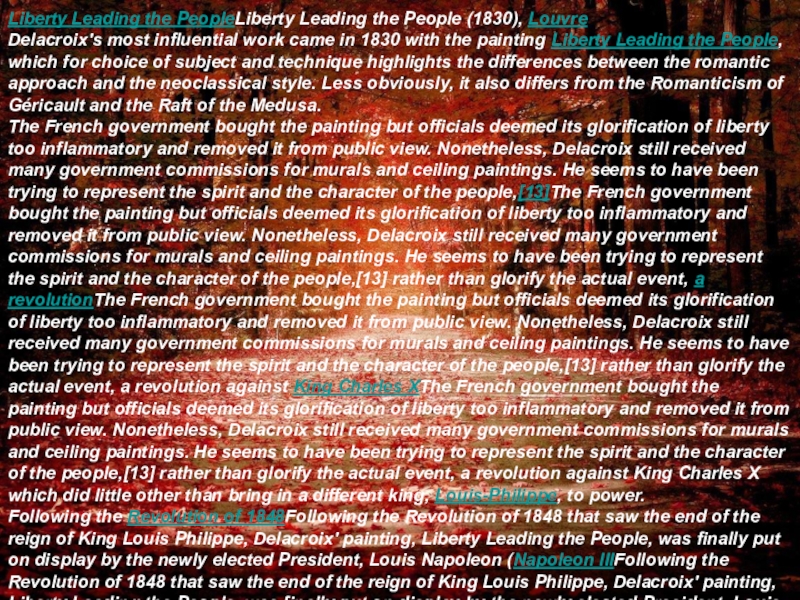
Слайд 17Travel to North Africa
In 1832, Delacroix traveled to Spain and
North Africa, as part of a diplomatic mission to MoroccoIn 1832, Delacroix traveled to Spain and North Africa, as part of a diplomatic mission to Morocco shortly after the French conquered AlgeriaIn 1832, Delacroix traveled to Spain and North Africa, as part of a diplomatic mission to Morocco shortly after the French conquered Algeria. He went not primarily to study art, but to escape from the civilization of Paris, in hopes of seeing a more primitive culture.[13]In 1832, Delacroix traveled to Spain and North Africa, as part of a diplomatic mission to Morocco shortly after the French conquered Algeria. He went not primarily to study art, but to escape from the civilization of Paris, in hopes of seeing a more primitive culture.[13] He eventually produced over 100 paintings and drawings of scenes from or based on the life of the people of North Africa, and added a new and personal chapter to the interest in OrientalismIn 1832, Delacroix traveled to Spain and North Africa, as part of a diplomatic mission to Morocco shortly after the French conquered Algeria. He went not primarily to study art, but to escape from the civilization of Paris, in hopes of seeing a more primitive culture.[13] He eventually produced over 100 paintings and drawings of scenes from or based on the life of the people of North Africa, and added a new and personal chapter to the interest in Orientalism.[14]In 1832, Delacroix traveled to Spain and North Africa, as part of a diplomatic mission to Morocco shortly after the French conquered Algeria. He went not primarily to study art, but to escape from the civilization of Paris, in hopes of seeing a more primitive culture.[13] He eventually produced over 100 paintings and drawings of scenes from or based on the life of the people of North Africa, and added a new and personal chapter to the interest in Orientalism.[14] Delacroix was entranced by the people and the costumes, and the trip would inform the subject matter of a great many of his future paintings. He believed that the North Africans, in their attire and their attitudes, provided a visual equivalent to the people of Classical RomeIn 1832, Delacroix traveled to Spain and North Africa, as part of a diplomatic mission to Morocco shortly after the French conquered Algeria. He went not primarily to study art, but to escape from the civilization of Paris, in hopes of seeing a more primitive culture.[13] He eventually produced over 100 paintings and drawings of scenes from or based on the life of the people of North Africa, and added a new and personal chapter to the interest in Orientalism.[14] Delacroix was entranced by the people and the costumes, and the trip would inform the subject matter of a great many of his future paintings. He believed that the North Africans, in their attire and their attitudes, provided a visual equivalent to the people of Classical Rome and Greece:
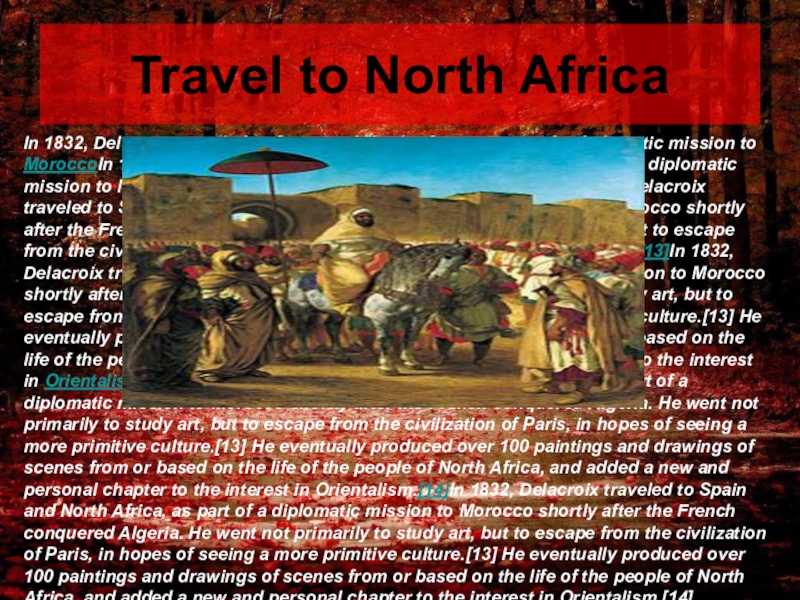
Слайд 18Murals and later life
In 1838 Delacroix exhibited Medea about to Kill
Her Children, which created a sensation at the Salon. His first large-scale treatment of a scene from Greek mythology, the painting depicts MedeaIn 1838 Delacroix exhibited Medea about to Kill Her Children, which created a sensation at the Salon. His first large-scale treatment of a scene from Greek mythology, the painting depicts Medea clutching her children, dagger drawn to slay them in vengeance for her abandonment by JasonIn 1838 Delacroix exhibited Medea about to Kill Her Children, which created a sensation at the Salon. His first large-scale treatment of a scene from Greek mythology, the painting depicts Medea clutching her children, dagger drawn to slay them in vengeance for her abandonment by Jason. The three nude figures form an animated pyramid, bathed in a raking light which penetrates the grotto in which Medea has hidden. Though the painting was quickly purchased by the State, Delacroix was disappointed when it was sent to the Lille Musée des Beaux-ArtsIn 1838 Delacroix exhibited Medea about to Kill Her Children, which created a sensation at the Salon. His first large-scale treatment of a scene from Greek mythology, the painting depicts Medea clutching her children, dagger drawn to slay them in vengeance for her abandonment by Jason. The three nude figures form an animated pyramid, bathed in a raking light which penetrates the grotto in which Medea has hidden. Though the painting was quickly purchased by the State, Delacroix was disappointed when it was sent to the Lille Musée des Beaux-Arts; he had intended for it to hang at the Luxembourg, where it would have joined The Barque of DanteIn 1838 Delacroix exhibited Medea about to Kill Her Children, which created a sensation at the Salon. His first large-scale treatment of a scene from Greek mythology, the painting depicts Medea clutching her children, dagger drawn to slay them in vengeance for her abandonment by Jason. The three nude figures form an animated pyramid, bathed in a raking light which penetrates the grotto in which Medea has hidden. Though the painting was quickly purchased by the State, Delacroix was disappointed when it was sent to the Lille Musée des Beaux-Arts; he had intended for it to hang at the Luxembourg, where it would have joined The Barque of Dante and Scenes from the Massacres of Chios
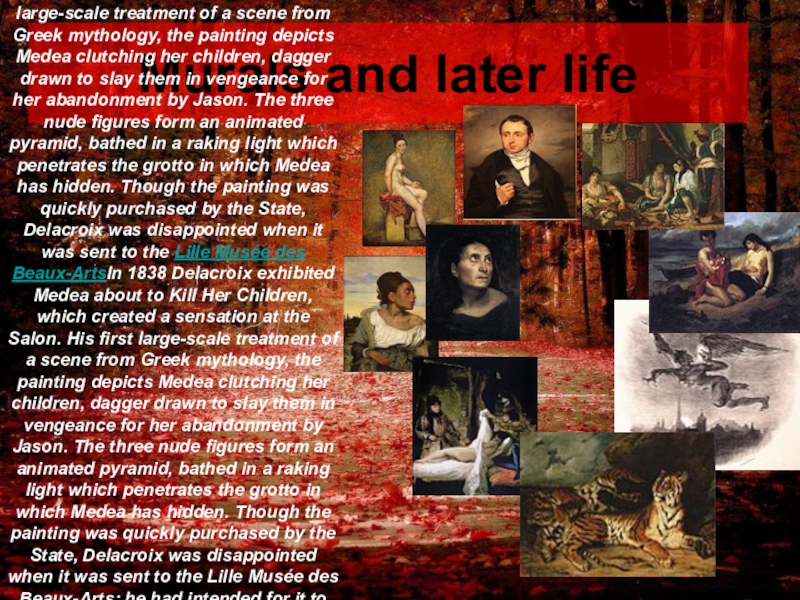
Слайд 19Monument to Delacroix, at the Jardin du Luxembourg.
Delacroix 's tomb
in the Père Lachaise Cemetery.
Слайд 21«Russia - country of landscapes …
I hope the time will
come, when all Russian nature, alive and penetrated by spirit will look from canvases of Russian artists…»
( Ivan Shishkin).
Слайд 22Biography
Ivan Ivanovich Shishkin (Russian: Иван Иванович Шишкин, 13 (25) January
1832 – 8 (20) March 1898) was a Russian landscape painter closely associated with the Peredvizhniki movement.
Russian landscape painter, artist, draftsman and printmaker. Academician (1865), professor (1873), head of landscape workshop (1894-1895) of the St. Petersburg Academy of Arts. Founder and member of the Peredvizhniki movement. Master of lithography and etching. Outstanding landscape master, he inherently combines romanticism and realism features in his paintings and graphics.
The works of this outstanding artist enjoy vast popularity in Russia; the best of them have become the classics of Russian landscape painting. During 40 years of his artistic activity Ivan Shishkin produced hundreds of paintings, thousands of studies and drawings and a large number of engravings. For contemporaries, Shishkin’s personality embodied Russian nature itself; they called him “forest tzar”, “old pine tree”, and “lonely oak”.
Слайд 23Ivan Ivanovich Shishkin was born in the town of Elabuga of
Vyatka Governorate (today Republic of Tatarstan) into the family of a merchant, and graduated from the Kazan gymnasium.
His father, a self-made and broad-minded man, after long hesitations, supported his son's desire to become an artist. In 1852-1856, Shishkin studied in the Moscow School of Painting and Sculpture, in 1856-1860, he continued his studies in St. Petersburg, in the Imperial Academy of Arts. He made rapid progress and got all the awards the Academy offered. Having received a Major Gold Medal for two pictures with the same name View of Valaam Island. Kukko (1860) and an Academy grant for studies abroad, Shishkin spent 3 years (1862-1865) in Germany, Switzerland, Czech, France, Belgium and Holland. Gradually he got disappointed in his foreign teachers and European authorities in landscape painting. Now he felt free and independent and longed to return home, to Russia.
Слайд 24During his stay abroad Shishkin engaged in lithography and etching. His
numerous pen drawings caught the eye of the Dusseldorf public and critics by their virtuoso hatching and filigree treatment of detail. In 1865, Shishkin painted his View near Dusseldorf for which he was awarded the title of Academician and which was shown at the 1867 World Fair in Paris.
He also took part in exhibitions at the Academy of Arts, the All Russian Exhibition in Moscow (1882), the Nizhniy Novgorod (1896), and the World Fairs (Paris, 1867 and 1878, and Vienna,1873). Shishkin's painting method was based on analytical studies of nature. He became famous for his forest landscapes, and was also an outstanding draftsman and a printmaker.
Shishkin became a member of the Imperial Academy in St. Petersburg and was professor of painting from 1873 to 1898. At the same time, Shishkin headed the landscape painting class at the Higher Art School in St. Petersburg.
He died in his studio at the easel with newly begun canvas.
Слайд 25As his best masterpieces such pictures are considered also: Morning in
a Pine ForestAs his best masterpieces such pictures are considered also: Morning in a Pine Forest (1889), In the northern wilderness...As his best masterpieces such pictures are considered also: Morning in a Pine Forest (1889), In the northern wilderness... (1891), In a wood of countess Mordvinovoj. PeterhofAs his best masterpieces such pictures are considered also: Morning in a Pine Forest (1889), In the northern wilderness... (1891), In a wood of countess Mordvinovoj. Peterhof (1891), Rain in an oak woodAs his best masterpieces such pictures are considered also: Morning in a Pine Forest (1889), In the northern wilderness... (1891), In a wood of countess Mordvinovoj. Peterhof (1891), Rain in an oak wood (1891), Pine Forest in Sestroretsk (1896) and others.
Some of his pictures - RyeSome of his pictures - Rye (1878), Amidst the open valley...Some of his pictures - Rye (1878), Amidst the open valley... (1883), Wood distances (1884) – are naturally perceived as romantic - symbolical images of Russia.
Shichkin had a troubled private life, twice he fell in love and married and twice his wives died. His sons also died. But never Shishkin allowed his sorrows appear on his canvases. His last work is Mast-Tree Grove (1898).
Among the Russian landscape painters Shishkin was the staunchest and most consistent exponent of the materialistic aesthetics – to depict nature in all its pure, unadorned beauty. His role in Russian art did not lose its significance even in the years, which saw the appearance of splendid landscapes by Isaac LevitanAmong the Russian landscape painters Shishkin was the staunchest and most consistent exponent of the materialistic aesthetics – to depict nature in all its pure, unadorned beauty. His role in Russian art did not lose its significance even in the years, which saw the appearance of splendid landscapes by Isaac Levitan, Valentin SerovAmong the Russian landscape painters Shishkin was the staunchest and most consistent exponent of the materialistic aesthetics – to depict nature in all its pure, unadorned beauty. His role in Russian art did not lose its significance even in the years, which saw the appearance of splendid landscapes by Isaac Levitan, Valentin Serov and Constantin Korovin.
Despite the fact that he espoused different aesthetic principles and advocated a different artistic system, Shishkin enjoyed an indisputable authority among young Russian painters of the late 19th century. The new generation did not fail to acknowledge him as a thoughtful and masterful portrayer of Russian nature.
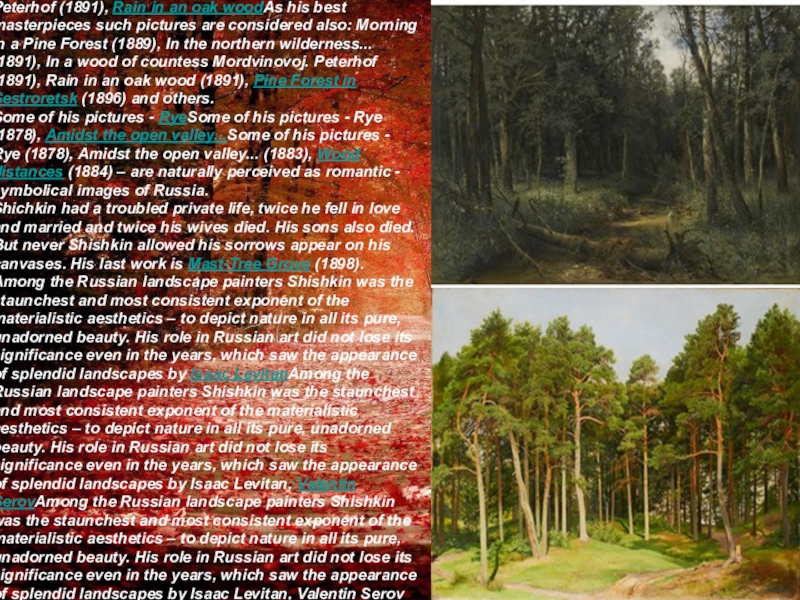
Слайд 26Ilya Repin
Great changes in thought occured in late nineteenth century
Russia. Writers and painters became increasingly interested in representing the harsh experiences of the peasants. Repin was a leading proponent of this realist movemen
Слайд 27Early Life of Ilya Repin
Ilya Efimovich Repin was born on
5th August 1844 in Chuguev, a city in Eastern Ukraine. At the time it was a military settlement, and Repin’s parents were very much a part of this world. As a young boy Repin studied with the icon painted Bunakov and showed tremendous talent.
Ilya Repin – St Petersburg and the Rebellion of the Fourteen
Repin moved to St Petersburg at the age of nineteen to study art formally. He began his work at the Drawing School of the Society for the Support of Artists (1863-4), where he studied under Ivan Kramskoi (1837-87) – a man who would be an important influence on the young artist in the future.
Kramskoi led the ‘Rebellion of the Fourteen,’ where fourteen students resigned from the St Petersburg Academy of Arts in protest at the strict rules for the Gold Medal Prize. Artists could not choose their own work and had to stick to traditional subject matter. Repin must have observed this scandalous event, and it certainly influenced his work as a realist painter.
By 1864 Repin was admitted to the Academy himself, and ironically won the Gold Medal for his diploma work, Raising of Jairus’ Daughter (1871) This gave him a six year scholarship, including three years study overseas. After graduating he painted Barge Haulers on the Volga (1871-3) before commencing his travel.
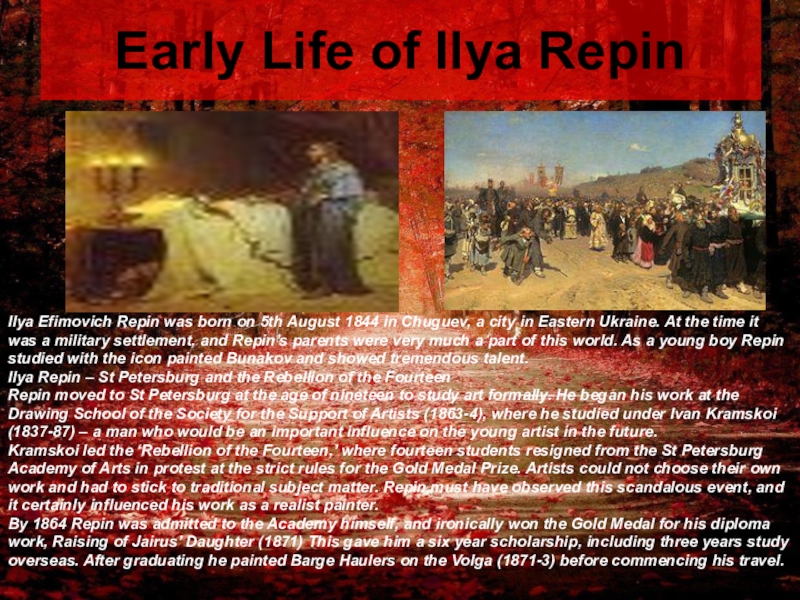
Слайд 28Ilya Repin - Travels Abroad
In 1873 he travelled to Europe,
initially touring Italy before settling and working in Paris until 1876. It was here that he saw the first Impressionist exhibition. Although he was not directly inspired by their work, parallels exist in the focus on truth: nineteenth century Russian Realists were passionate about depicting the harsh reality of peasant life; the Impressionists looked at the ever-changing nature of light and atmosphere.
Слайд 29Ilya Repin’s Golden Period
After his time overseas Repin returned to
his hometown. In 1878 he moved to St Petersburg and joined the Society of Wandering Exhibitions, founded by seven of the fourteen St Petersburg rebels, including Kramskoi. Repin formed a close friendship with his former teacher and become an important member of the group, which sought to emphasize the social and political aspects of art, as opposed to pure form. This paralleled the realist movement in literature, best exemplified by Tolstoy and Dostoevsky. From 1878-82 he also become a core member of Savva Mamontov’s Abramtsevo Art Circle.
In 1882 he returned to St Petersburg where he created some of his greatest worksIn 1882 he returned to St Petersburg where he created some of his greatest works, including Refusal of the Confession (1879-85), including two portraits of Leo Tolstoy (1887) and Ivan the Terrible and his Son Ivan (1895).
Слайд 30Ilya Repin’s Later Years
Although Repin did not paint any masterpieces
after 1900, probably due to the atrophy of his right hand, his personal life was fulfilling. He fell in love with Natalia Nordman and hosted ‘Wednesday at the Penaty’ events at her home of the same name in Kukkuola, Finland. They were attended by the greatest Russian artists and thinkers of the day. In 1948 the town was renamed Repino in his honour, eighteen years after his death in 1930.
